





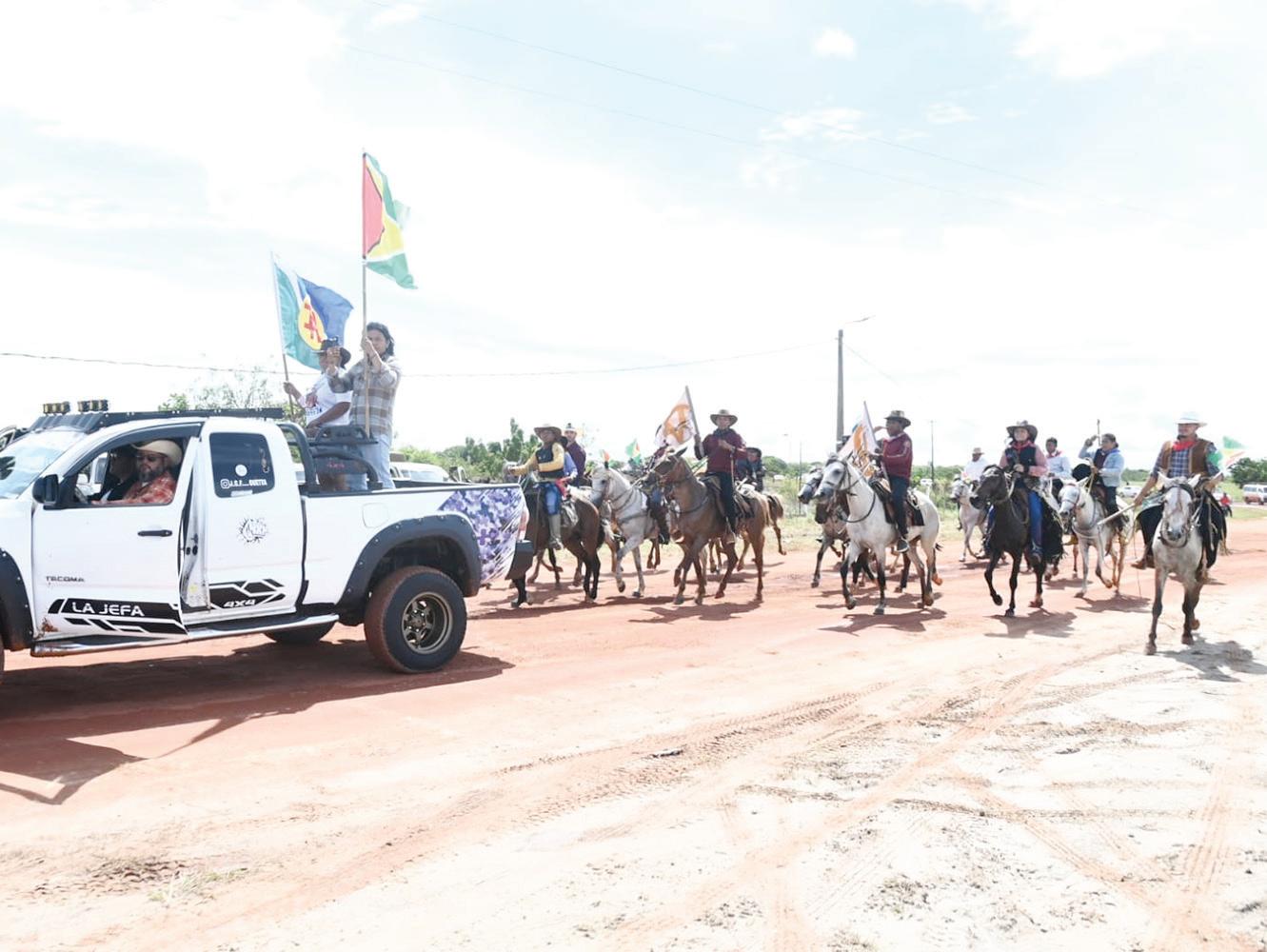








See below a message from His Excellency, President Irfaan Ali, on the occasion of Easter:
My Fellow Guyanese at home and in the diaspora, A blessed and joyous Easter to each and every one of you!
At this time of the year, we join our Christian brothers and sisters across the country and around the world in celebrating the most sacred and central event in their faith — the Resurrection of Jesus Christ. Easter is not simply a holy day on the Christian calendar; it is the defining moment of Christian belief — the victory of life over death and of hope over despair.
The message of Easter is one of ultimate triumph. Christians believe that through His crucifixion, Jesus Christ bore the burden of humanity’s sins, and
by His resurrection, He broke the bonds of death, offering redemption and new life to all. It is this belief that inspires unshakable hope, renews faith, and calls on the faithful to live lives marked by love, sacrifice, and compassion.
And so, Easter is a time of great rejoicing — a time to lift up hearts in praise, a time to reflect deeply on the power of renewal, and a time to embrace the promise of better days.
In Guyana, Easter is not only a religious celebration but also a cultural tradition embraced by all — Christians and non-Christians alike. Across our beautiful country, families gather, children fly colorful kites, and communities come alive with the sights and sounds of joy. Easter in Guyana is a season of happiness.
We fly our kites high
to remind ourselves of the risen Christ. We picnic with loved ones in the spirit of unity and togetherness. We cheer on the excitement of the Lethem Rodeo and delight in the fun of the Bartica Regatta. Our beaches, parks, and open spaces become arenas of laughter, music, and merriment. Yes — Easter in Guyana is special.
But even as we celebrate and revel in the joy of the season, let us not forget the importance of safety. Whether we are on the road, at the river, in the hinterland, or in the heart of Georgetown, let us be careful. Let us be respectful. Let us look out for one another. A joyful people must also be a responsible people. Let us seek to use our roads and waterways in a safe manner.
Let us also continue to cultivate the values that


hold us together: love for neighbor, kindness in action, and respect for differences. These are the values that have sustained us through both good and bad times. These are the values that will carry us forward.
For in our diversity, we find our strength. And in our unity, we find our power.
Let this Easter be a reminder that we are all part of one great Guyanese family — one people, one nation, with one destiny. Regardless of our faith, our background, or our geography, we all want a better
future for our children, our families, and our country.
And that future is within our reach. As a nation, we are moving steadily and confidently toward the goal of shared prosperity. But prosperity must be more than wealth — it must be peace of mind, dignity in living, fairness in opportunity, and hope in every household. That kind of prosperity comes not just from economic growth, but from social cohesion — from the everyday choices we make to treat one another with dignity and care.
So, as we fly our kites
and share our meals, as we worship in our churches and relax on our beaches, let us do so with hearts full of gratitude — and with a renewed commitment to building a Guyana that is safe, strong, and united.
Let this Easter not only be a season of celebration, but a time of reflection and rededication. Together, we can rise.
On behalf of the Government and people of Guyana, and myself and family, I wish peace, love, and joyful fellowship to all during this Easter season.
Happy Easter!


By Trina Williams
President Irfaan Ali on Saturday revealed plans to build at least 1,000 core homes across Region Nine (Upper Takutu- Upper Essequibo) if the People’s Progressive Party/Civic (PPP/C) is elected for a second term in office.
“In our next term in government, we are going to expand the housing project and core homes project in Region Nine. We have to build at least 1,000 of those core homes across Region Nine,” the President stated during his visit to Yupukari Village on Saturday.
During one of his many meetings with residents on Saturday, President Ali highlighted numerous programmes which have benefited Region Nine. He spoke about the rainwater harvesting tanks that will be given

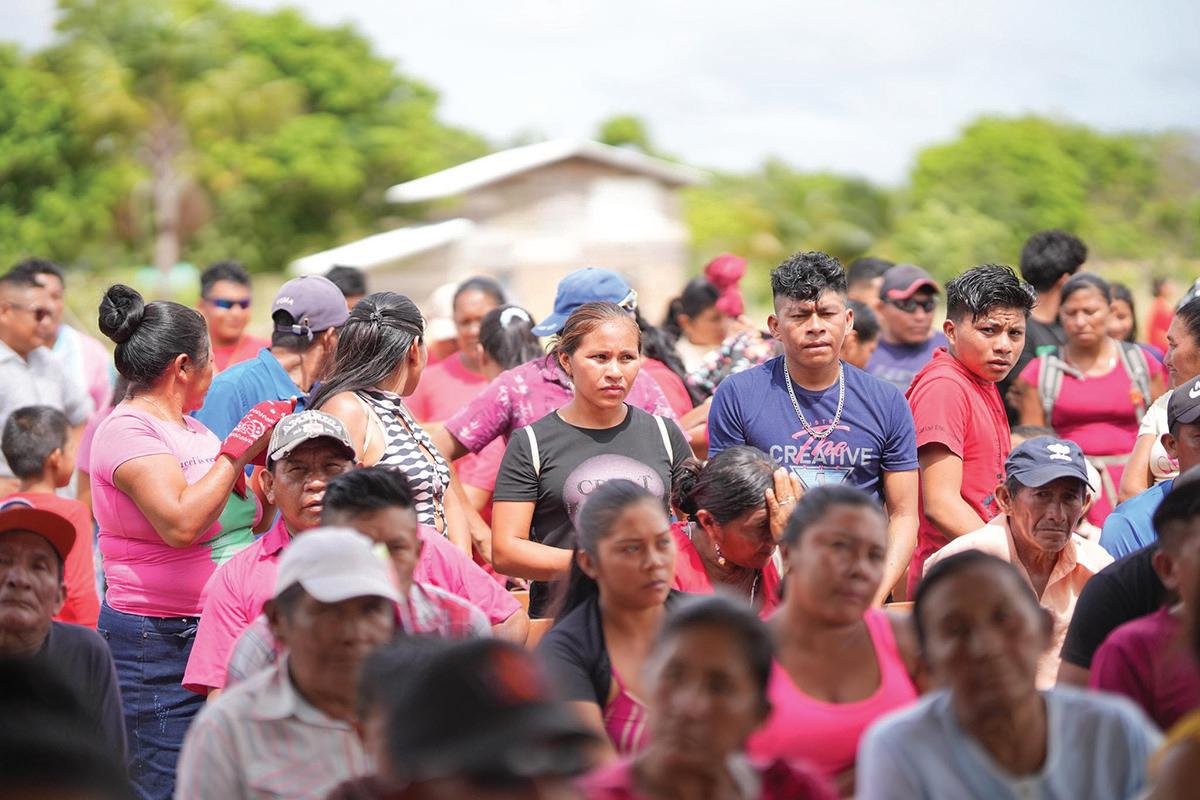

to 516 households, ensuring every family can harness rainwater from their improved roofs.
The President also hinted at developing a housing scheme in Kaicumbay. “I have asked the Minister of Housing to take note of this and to see how we can support this because in our next term in government, we are going to expand housing support and the core homes project in Region Nine,” the President said.
President Ali declared that the region is no longer shackled by the broken promises and neglect of the political opposition, as he highlighted the renewed wave of development and
government support now flowing into the region. He contrasted this with what he described as a grim and stagnant period under the former APNU+AFC administration — a time when critical sectors such as education, healthcare, and transportation were left to deteriorate without meaningful intervention.
“So, you have a friend, a trusted friend, in the People's Progressive Party/Civic Government, you have in the People's Progressive Party/Civic government, our commitment to hard work, our dedication to service, our servanthood leadership that seeks to always put the people first. You are the centre of development.

So, as we continue to work together, as we continue to build together, always know you have a reliable partner in the People's Progressive Party/Civic,” the Head of State noted.
DODGING
With the opposition possessing a track record characterised by placing hardships on the backs of citizens, President Ali said this is the reason they dodge accountability.
“When you ask them (APNU+AFC) about all that took place in their latest version of being in government, you know what their response is? ‘Don't bother with the past, let’s worry about the future.’ They have no basis,
no grounding. They have no principle on which they can report on their report card in government.”
The President touted the PPP government’s accomplishments but shifted focus to the future, urging citizens to share their ideas for the next five years.
“We believe in the power of the people, the power of the ideas that come from the people, that power is what brings the greatest community development, and that is the philosophy of the People's Progressive Party. The APNU+AFC never give you a dime every day. The PPP is at the grind,” President Ali told the residents.
ROCK OF GUYANA
President Ali recalled
the many ways in which Amerindian communities were disrespected and sidelined under the APNU+AFC administration. In contrast, he emphasised that under the PPP government, Amerindians are not only being empowered with real opportunities but are also witnessing tangible development in their villages.
He said: “You are the rock of this nation, you are the foundation, you are the first people, and you deserve the highest and greatest of respect and regards. That is why, continuously, we'll invest in you.”
Speaking on the strides in education, President Ali highlighted that under the PPP government, teacher
training has significantly expanded, with over 473 teachers currently undergoing training in the region alone.
“It is not by accident that you now have 473 teachers who are under training. It is because of the investments we have made to ensure that your children have access to secondary education that gives them the basis on which they can now enter the teaching profession,” he said.
President Ali also underscored the PPP government’s commitment to ensuring full access to education for all, highlighting it as a cornerstone of national development. He shared a heartfelt moment following the commissioning of the Katoka Secondary School, reflecting on the transformative impact such institutions have on remote communities.
“What touched me is that two young girls came up and said, ‘Mr. President, we can now dream of being doctors without fear, because we can now do science in this secondary school.’ And I always tell the young people, don't take this for granted,” President Ali noted.
He also highlighted that hundreds within the region are being trained in the health sector to become community health workers, nursing assistants, medical laboratory technicians, etc.
(BBC) - Russian President Vladimir Putin says he has ordered his forces to “stop all military activity” in Ukraine, as he declared an “Easter truce” until the end of Sunday. He said the 30-hour truce would last until 22:00 BST on Sunday (00:00 Moscow time), adding that Russian forces should be prepared to respond to “any possible violations”.
Ukrainian President Volodymyr Zelensky said Kyiv would adhere to the truce, but accused Moscow of breaking it. “If Russia is now suddenly ready to truly engage in a format of full and unconditional silence, Ukraine will act accordingly - mirroring Russia’s actions,” he said.
“Our actions are and will be symmetrical. The proposal

for a full and unconditional 30-day silence remains on the table — the answer to it must come from Moscow,” he wrote on X. He said fighting continued in Russia’s Kursk and Belgorod regions and Russian drones were still in use, but added that some areas had become quieter.
had a long history of his statements not matching his actions. We know his words cannot be trusted and we will look at actions, not words,” he added.
Putin announced the temporary truce at a meeting with his chief of general staff, Valery Gerasimov. “Based on

Zelensky said Ukraine would be ready to extend a truce beyond 20 April, seemingly referring to an earlier proposal from the US for a 30day ceasefire which Ukraine had already agreed to. Responding to Putin’s initial announcement, Ukraine’s Foreign Minister Andriy Sybiha wrote on X: “Putin has now made statements about his alleged readiness for a cease-fire. 30 hours instead of 30 days.”
“Unfortunately, we have

suddenly announced - a previous attempt at a ceasefire during Orthodox Christmas in January 2023 fell apart after both sides failed to agree on a proposal.
Russia launched a fullscale invasion of Ukraine on 24 February, 2022. It is estimated that hundreds of thousands of people - the vast majority of them soldiershave been killed or injured on all sides.
(BBC) - Pakistan has deported more than 19,500 Afghans this month, among more than 80,000 who have left ahead of a 30 April deadline, according to the UN. Pakistan has accelerated its drive to expel undocumented Afghans and those who had temporary permission to stay, saying it can no longer cope. Between 700 and 800 families are being deported daily, Taliban officials say, with up to two million people expected to follow in the coming months.
my whole life in Pakistan,” said Sayed Rahman, a second-generation refugee born and raised in Pakistan. “I got married there. What am I supposed to do now?”
Saleh, a father of three daughters, worried what life under Taliban rule will mean for them. His daughters attended school in Pakistan’s Punjab province, but in Afghanistan, girls over the age of 12 are barred from doing so.
humanitarian considerations... the Russian side announces an Easter truce. I order a stop to all military activities for this period,” Putin told Gerasimov “We assume that Ukraine will follow our example. At the same time, our troops should be prepared to repel possible violations of the truce and provocations by the enemy, any aggressive actions.” The Russian defence ministry said its troops would adhere to the ceasefire provided it was “mutually respected” by Ukraine.
It is not the first time a pause in fighting has been
The US has been directly talking to Russia as part of its efforts to end the war, but has struggled to make major progress. Last month, Moscow rejected a proposal for a full and unconditional ceasefire that had been agreed by the US and Ukraine. US President Donald Trump on Friday warned Washington would “take a pass” on brokering further talks on ending the war in Ukraine unless there was quick progress.
He was speaking after Secretary of State Marco Rubio said the US was not “going to continue with this endeavour for weeks and months on end”, as it had “other priorities to focus on”.
“We need to determine very quickly now - and I’m talking about a matter of days - whether or not this is doable,” he added. “If it’s not going to happen, then we’re just going to move on.”

Pakistani Foreign Minister Ishaq Dar flew to Kabul on Saturday for talks with Taliban officials. His counterpart Amir Khan Muttaqi expressed “deep concern” about deportations. Some expelled Afghans at the border said they had been born in Pakistan after their families fled conflict.
More than 3.5 million Afghans have been living in Pakistan, according to the UN’s refugee agency, including around 700,000 people who came after the Taliban takeover in 2021. The UN estimates that half are undocumented.
Pakistan has taken in Afghans through decades of war, but the government says the high number of refugees now poses risks to national security and causes pressure on public services. There has been a recent spike in border clashes between the security forces of both sides. Pakistan blames them on militants based in Afghanistan, which the Taliban deny.
Pakistan’s foreign ministry said the two sides had “discussed all issues of mutual interest” in Saturday’s meeting in Kabul. Pakistan had extended a deadline for undocumented Afghans to leave the country by a month, to 30 April.
On the Torkham border crossing, some expelled Afghans told the BBC they left Afghanistan decades ago - or had never lived there. “I lived
“I want my children to study. I don’t want their years in school to go to waste,” he said. “Everyone has the right to an education.” Another man told the BBC: “Our children have never seen Afghanistan and even I don’t know what it looks like anymore. It might take us a year or more to settle in and find work. We feel helpless.”At the border, men and women pass through separate gates, under the watch of armed Pakistani and Afghan guards. Some of those returning were elderly – one man was carried across on a stretcher, another in a bed.
Military trucks shuttled families from the border to temporary shelters. Those originally from distant provinces stay there for several days, waiting for transport to their home regions. Families clustered under canvases to escape the 30C degree heat, as swirling dust caught in the eyes and mouth. Resources are stretched and fierce arguments often break out over access to shelter.
Returnees receive between 4,000 and 10,000 Afghanis (£41 to £104) from the Kabul authorities, according to Hedayatullah Yad Shinwari, a member of the camp’s Taliban-appointed finance committee. The mass deportation is placing significant pressure on Afghanistan’s fragile infrastructure, with an economy in crisis and a population nearing 45 million people.

(BBC) - The US Supreme Court has ordered the Trump administration to pause the deportation of a group of alleged Venezuelan gang members . A civil liberties group had sued to stop the removal of the men, currently in detention in Texas, saying they had not been able to contest their cases in court .
Donald Trump has sent accused Venezuelan gang members to a notorious prison in El Salvador, invoking the 1798 Alien Enemies Act, which gives the president power to detain and deport natives or citizens of “enemy” nations without usual processes. The act was previously used only three times, all during war
The White House called challenges to using the law for mass deportations “meritless litigation”.
“We are confident in the lawfulness of the administration’s actions and in ultimately prevailing against
an onslaught of meritless litigation brought by radical activists who care more about the rights of terrorist aliens than those of the American people,” White House Press Secretary Karoline Leavitt wrote in a post on X.
The Alien Enemies Act was last invoked in World War Two, when people of Japanese descent were imprisoned without trial and thousands sent to internment camps. Since taking office in January, Trump’s hard -line immigration policies have encountered a number of legal hurdles
Trump had accused Venezuelan gang Tren de Aragua of “perpetrating , attempting, and threatening an invasion or predatory incursion” on US territory.
Out of 261 Venezuelans deported to El Salvador as of 8 April, 137 were removed under the Alien Enemies Act, a senior administration official told CBS News, the BBC ’s US news partner.
A lower court tempo -
rarily blocked these deportations on 15 March. The Supreme Court initially ruled on 8 April that Trump could use the Alien Ene -
north Texas had been given notices about their imminent deportation in English, despite one detainee only speaking Spanish.
intervention, dozens or hundreds of proposed class members may be removed to a possible life sentence in El Salvador with no real
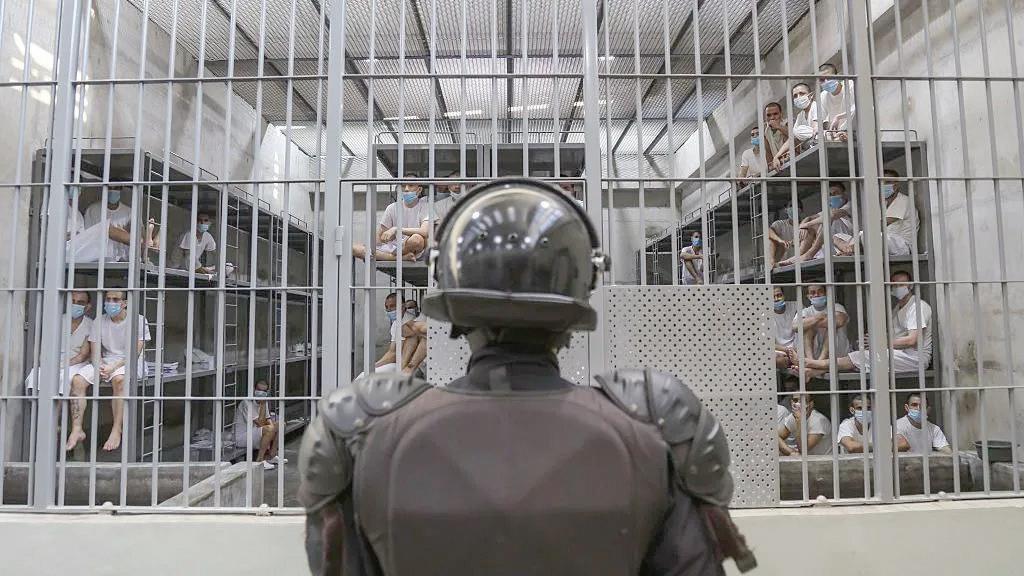
mies Act to deport alleged gang members, but deportees must be given a chance to challenge their removal.
The lawsuit that resulted in Saturday’s order said the Venezuelans detained in
The challenge by the American Civil Liberties Union (ACLU) also said the men had not been told they had a right to contest the decision in court.
“Without this Court’s
opportunity to contest their designation or removal,” the lawsuit read
Supreme Court Justices Clarence Thomas and Samuel Alito dissented on Saturday. In his second in -
augural address in January, Trump pledged to “eliminate the presence of all foreign gangs and criminal networks bringing devastating crime to US soil”.
In the highest -profile case, the government admitted it mistakenly deported El Salvador national Kilmar Ábrego García, but contends he is a member of the MS-13 gang, which his lawyer and family denies. Mr Ábrego García has never been convicted of a crime.
The Supreme Court unanimously ruled that the government should facilitate bringing back Mr Ábrego García, but the Trump administration has said he will “never” live in the US again Senator Chris Van Hollen, a Democrat from Maryland, visited Mr Ábrego García in El Salvador and said he had been moved from the mega-jail Cecot (Terrorism Confinement Centre) to a new prison.
(Reuters) - Brazil should not explore oil reserves in the Amazon region, because of the dangerous impact on local communities, Indigenous leader Raoni Metuktire, of

the Kayapo people, told Reuters during the country’s largest Indigenous gathering last week.
Raoni’s comments at the gathering, called Acampamento Terra Livre, come as debate heats up around Brazil’s state-run oil firm Petrobras’
(PETR4.SA), opens new tab bid to drill for oil off the coast of the Amazonian state of Amapa, in the sensitive Foz do Amazonas basin.
“I’m against this oil project,” said Raoni, days after he met with Brazilian President Luiz Inacio Lula da Silva. “I

personally told President Lula that I am against it, I do not accept this oil in the Amazon.”
Though Lula has sought to be recognized as a champion of the world’s tropical forests and Brazil’s Indigenous peoples, he has also said that the country should be able to drill in the environmentally sensitive Foz do Amazonas basin. He has criticized the country’s environmental agency Ibama for its delay in giving Petrobras a license to do so.
Raoni, who has been an internationally recognized environmental campaigner for decades, was one of the few people invited by Lula to stand by him when he was sworn in
for his third term as president in January 2023.
In May 2023, Ibama denied Petrobras’ request for an offshore drilling license for Foz do Amazonas, citing environmental concerns. It later also highlighted concerns over the effects the drilling could have on Amapa’s Indigenous communities. The oil company appealed, but a final Ibama decision is pending.
The Foz do Amazonas basin is in Brazil’s Equatorial Margin, considered the country’s most promising oil frontier, sharing geology with nearby Guyana, where Exxon Mobil is developing huge oil fields.


FOLLOWING a recent suggestion by a Chinese official to engage Venezuela in "friendly consultations and negotiations", Guyana's adamant stance on the border issue is an unmistakable sign that the nation remains dedicated to the International Court of Justice (ICJ) process, and will not engage in anything outside of this. The recent action by the Chinese diplomat is ill-timed, and, in principle, misguided.
The Ministry of Foreign Affairs and International Cooperation was right to
immediately and categorically reject this proposal, reaffirming that the only legitimate avenue of resolution is the ICJ, where the matter is already under active adjudication.
This is not a technicality.
The roots of the border conflict date back to the 1899 Arbitral Award, a landmark ruling defining the border between Guyana and Venezuela, which was accepted by the international community for decades.
Venezuela's attempts to invalidate this award and assert its claims, most recently
in the guise of sham elections for an alleged "Guayana Esequiba State" within Guyana's sovereign territory, are not acts of goodwill but flagrant violations of international law and the sovereignty of Guyana.
Demands for "friendly negotiations" disregard the fact that Venezuela has consistently sabotaged trust, and ratcheted up tensions, including by threatening Guyana's economic development and security.
The role of the ICJ is not only warranted but necessary to guarantee a just, rules-
based resolution that enforces the principles of sovereignty and non-use of force.
To enable simultaneous negotiations outside the Court would only be to erode the ICJ's jurisdiction, and to reward Venezuela's disregard for international norms.
Guyana's position is also supported by major international actors, including the United States and the Organisation of American States (OAS), who have made abundantly clear their support for Guyana.
The Argyle Declaration of December 2023 binds
Guyana and Venezuela to shun actions that will inflame tension, an action already in breach by Venezuela’s actions to take steps unilaterally. Platitude concerning "amicable means" is hollow when there is one side which is taking steps to breach agreements and vitiate the peace.
Guyana's insistence on the ICJ process is not stubbornness; it is the commitment to principle concerning international order.
The reluctance on the part of the government to be tempted into side negotia -
tions is in the protection of its legal rights and national sovereignty. Guyana has to remain vigilant and resolute more than ever now.
Any move to short-circuit the ICJ, no matter how benevolent the intentions, would risk giving legitimacy to aggression, and establishing a dangerous precedent for small states everywhere. Guyana is correct to say "no" to diversion, and "yes" to justice. The border controversy will be resolved in The Hague, not in the backrooms of diplomacy.
In the upcoming election, voters will have a choice between proven altruism and egoism
Dear Editor,
FOMENTING strife and/or civil unrest in Guyana is not yet commonplace, but incidents seem to be increasing, especially with general elections fast approaching.
By soliciting or drumming up public support, whether in the form of philanthropic ispensation, dubious claims of community representation, the advocacy of Afro-centric racism, or a call to action against anti-law enforcement practices, promoters of civil disturbance seem to frequently orchestrate antigovernment resistances, instigate protests, or incite violence, primarily aimed to optimize the ascendency of dubious political aspirants.
In this regard, could the 4/5/25 antigovernment resistance standoff at Azruddin’s home hold some clues? Let’s examine.
According to newspapers and video accounts, on 4/5/25, an “angry mob” hurling insults and threats, confronted government officials who arrived at Azruddin Mohamed’s secured, gated residence.
Authorised to take posses-
sion of some luxury vehicles for unpaid taxes owed to the government, the assigned officials and their police escort immediately found themselves face-to-face with an aggressive, boisterous crowd, which intimidated them into retreating in fear.
Whether intended or not, this raucous incident prompts a few thought-provoking questions: (i) Was it prudent, or reasoned politic, for a philanthropist and political aspirant to grant assemblage to a ‘hostile crowd’, practically at his doorstep, in preparation to hurl threats at government officials seeking to execute the law? (ii) What verifiable assurances can Azruddin provide to attest that such crowd mobilisation would not spill over into other legitimate government assessments, protocols, or regulations that he finds distasteful? (iii) What is the likelihood that such crowd mobilisation would not find expression in aggression and violence against political rivals fiercely critical of Azruddin, if he declares himself a political candidate? In the absence of valid answers/ assurances, these questions
become worthy of pondering.
Indeed, Guyanese recipients can readily affirm the Mohammeds’ generosity, especially since their awards help in improving the lives and circumstances of many. While admired for their charity, the incident at Aziruddin’s home and his reported interest in electoral politics call into question the aim or objective of his generosity. Is it altruistic or egoistic?
Altruistic Philanthropy is the charitable award of one’s resources to help others, or to positively impact social outcomes, i.e., bring about changes that will improve the lives and relations in communities and society. Customarily, purported to serve in the interest of recipients – the individual, community, or society - philanthropic donations, selflessly given, without expectations of reciprocity, or personal gains, would be deemed altruistic. But when given with selfish expectations to facilitate, promote, hasten, or enhance the preeminence of the donor as an honourable individual, then the donation becomes one of egoistic philanthropy. In toto, Egoistic Philanthropy
is awarded with expectations of personal gains, to popularise, promote, or enhance the donor’s worthiness, self-interest, and/or celebrity.
Given the contrasting distinctions, the onus rests with the Guyanese public to decide whether an individual indulges in altruistic or egoistic philanthropy. It would be presumptuous to assume that Guyanese cannot make reasoned decisions for themselves as to the aim/objective of philanthropic distributions.
In relation to the above, it should be noted that altruistic and egoistic behavioural proclivities extend beyond the dichotomisation of philanthropy. Ever since the French sociologist and philosopher Auguste Comte introduced the terms in the early 1850s, philosophers, social scientists, and natural scientists have applied altruistic and egoistic differentiations in their studies of behaviours, with some focusing on political leadership.
For example, an altruistic political leader refers to someone committed to addressing and serving the needs, interests, and well-being of all citizens, rather
than his/her own. Possessing qualities similar to those of a Servant Leader, an altruistic political leader dedicates himself/herself to communal and national growth and development. At the personal level, the altruistic-servant political leader exudes humility and modesty and exhibits an adeptness at relating to and interacting with constituents. For numerous Guyanese, Irfaan Ali exemplifies such a leader. What are your thoughts?
In contrast to the altruistic-servant political leader, the egoistic leader acts primarily in his/her own self-interest, is prone to self-promotion, and is insensitive to the overall needs and interests of citizens, or the development of the entire country. An egoistic political leader seldom relies on the advice of others, trusting instead his/her own abilities to promulgate and articulate community and national policies. Often aloof and displaying autocratic tendencies, the egoistic political leader relishes praise and often promotes himself/herself as a visionary of national development and progress. How many are in your midst?
Given the contrast, vot -
ers could easily identify the political leader(s) with altruistic or egoistic personality traits, someone whom they consider worthy of support. While no one can claim to have a monopoly on altruistic or egoistic behavioural tendencies and practices, the extent to which an individual exhibits altruistic over egoistic characteristics - and vice versa - helps in the determination of trustworthiness. It is in this regard that Guyanese can make informed decisions about their lived conditions and determine whose political leadership, or party, can best govern in accordance with the needs and interests of all. For those who may be apprehensive, feel free to mull over the following statement. Historically, when wealth and egoism become the primary criterion for one’s ascendency into political prominence and leadership, the poor and working class are damned. For, in leadership, triumph or tribulation dominates. Hence, your informed and responsible decision matters.
Regards, Narayan Persaud, PhD Professor Emeritus
Dear Editor,
IN Guyana and in many other Western nations, Easter is celebrated every year by mostly Christians who believe that Jesus’ death and resurrection are to forgive them of their sins. It is celebrated with a blend of religious traditions and vibrant cultural festivities, with kite flying being a particularly prominent and symbolic activity.
It is also a time for family gatherings, feasting, and spiritual reflection, as well as a chance to celebrate the resurrection of Jesus Christ. Along with the Nativity of Christ, Easter is one of the most important, blissful and joyous celebrations in the Christian calendar in Guyana.
It is when Christians glorify and give thanks for the Resurrection of Jesus Christ as their Saviour.
Easter is preceded by Lent, a forty-day period of fasting, praying and meditating, which begins on Ash Wednesday and ends on Holy Saturday. Most, if not all,
Christians believe in the Holy Book; the Bible, which tells them that Good Friday commemorates Jesus Christ's crucifixion, death and burial, and Easter Sunday is the celebration of his resurrection. It is the culmination of their Passion for Christ, which reinforces the belief that Christians can have an eternal home in heaven.
It strengthened the Christian belief that Christ is the Son of God, whose crucifixion on the cross was a sacrifice of His love, and the price He paid, and the suffering He endured for humanity.
Christians also believed that Christ's death offers hope for the future, both in their life on earth and in eternity: Heaven.
Christians view Jesus' death as a sacrificial act on behalf of humanity, offering atonement for sins, and paving the way for salvation and reconciliation with God. For them, it was not just a tragic event, but a pivotal moment in God's plan for humanity; a demonstration of love, forgiveness, and victory over death.
The Easter tradition in Guyana is about the Easter Bunny, colourfully-decorated eggs, Easter egg hunts, the baking of cross buns on Holy Thursday, and church services on Good Friday and Easter Sunday, which symbolise the joy and happiness felt by Christians.
Easter Monday, which is a holiday in Guyana and most Commonwealth co untries, including Canada but not in the United States, is also reserved for kite flying, picnics, family gatherings, and bonding throughout the country.
On this day, many, if not most, Guyanese from all walks of life will fly kites on the sea walls, at No. 63 Beach on the Corentyne, in backyards, and in open parks and savannahs around the country.
The skies will be littered with kites of all sizes, colours, styles and shapes. Kite flying is integral to Easter celebrations in Guyana, and it is every child’s dream to partake in it. It is a spirited,
fun-loving and relaxing activity that is peaceful and stressfree, and with lots to eat and drink, including “hot cross buns”, traditionally eaten on Good Friday to symbolise the crucifixion of Jesus Christ. The spices on top of the bun represent what was used to embalm him, and the fruit/ raisins in the dough signify his body in the tomb.
Studies have shown that the flying of kites dates back more than 2000 years. Though the exact date is not known, it is believed that the flying of kites first took place in Shandong, the most eastern province in China. We are told that a Chinese farmer in the Shandong Province tied a string to his hat to prevent it from blowing far away from him due to high winds. The hat was blown into the air, where the high wind swayed it back and forth. Emerging from this experience was the flying of the first kite known to Mankind.
The Chinese made the first kite from bamboo, which was used for the frame, and covered it with silk and paper
to make it light for flying.
The earliest known Chinese kites were flat and rectangular in shape. Some were decorated with mythological motifs and legendary Chinese figures; others were fitted with strings and whistles to make musical sounds while flying. Ancient and medieval Chinese sources have claimed that kites were used for measuring distances, testing the direction and the strength of the wind, signalling, and as a communication mechanism for military operations. The Chinese military used kites for dropping propaganda leaflets over enemy territories to warn them of an impending attack.
From China, kites were introduced to Cambodia, Thailand, India, Japan, Korea, and some Western countries. The most famous kite in history was created in 1750 in the United States, and flown by Benjamin Franklin during a rainstorm to prove that lightning bolts were indeed caused by electricity.
Here in Guyana, the flying of kites is a happy oc-
casion for most Guyanese, and while many will travel to meet friends and relatives, and to share in the fun and excitement with them, there will be heightened police presence in all the communities to ensure their safety, and to prevent accidents and traffic fatalities on the highways.
Drivers are warned to exercise caution, avoid speeding, and not to drink alcohol and drive. Pedestrians are also warned to be careful when using the roads.
Residents are also advised to use every precaution necessary to ensure their valuables are secured, and, when possible, they should travel in groups.
The message of Easter is one of hope, faith, devotion, and the appreciation of life, the possibility of an after-life and the triumph of good over evil, love instead of hatred, endurance and adversity.
We must rise to the occasion as we celebrate the crucifixion and resurrection of Christ.
Sincerely, Dr. Asquith Rose


THE much-anticipated ONE GUYANA Floating Production, Storage and Offloading (FPSO) vessel arrived in Guyana’s waters last Tuesday. Slated for operations in the Yellowtail development, it joins the Liza Destiny, Liza Unity, and Prosperity FPSOs al-
ready producing oil in the prolific Stabroek Block offshore Guyana. Constructed under SBM Offshore’s Fast4Ward® programme, the ONE GUYANA FPSO brings a production capacity of 250,000 barrels per day and storage for two million barrels of oil—a

critical addition to Guyana’s growing offshore operations. Once production begins later this year, national output is expected to climb to nearly 900,000 barrels per day—a remarkable milestone for a country that began producing oil just over five years ago, in December 2019.
In 2024 alone, Guyana earned US$2.57 billion (GY$ 536 billion) from its three operating FPSOs. With the arrival of this fourth vessel, those figures are poised to rise, but this isn’t just about numbers on a balance sheet—it’s about real, measurable impact on people’s lives.
Before it even reached our shores, the ONE GUY-
ANA FPSO was already creating opportunities for Guyanese. More than 200 tonnes of steel fixtures were fabricated locally by Industrial Fabrications Incorporated (InFab), Guyana Oil & Gas Support Services Inc. (GOGSSI), and ZECO Group of Services—demonstrating just how deeply local businesses are now embedded in the industry’s supply chain.
Now that the vessel is here, the benefits will multiply. These companies and others will play key roles in its ongoing maintenance, logistics, and support services. In addition to technical roles, Guyanese workers and businesses are also delivering es-

sential services—from catering and cleaning to transport and crew transfers. This isn’t just about oil—it’s about a diversified ecosystem that stretches into multiple sectors of the economy.
The FPSO’s arrival is a clear signal of how far Guyana has come, not just in oil production but in building local capacity and industry resilience. In a recent statement, Minister of Natural Resources Vickram Bharrat captured this well, noting:
“The arrival of the ONE GUYANA FPSO is a powerful symbol of progress, not only in oil production but in the continued empowerment of our people through job creation, local business opportunities, and increased revenues that support development across Guyana.”
The rollout of the Local Content App by the Local Content Secretariat is an -
other step towards making those opportunities more accessible, whether for entrepreneurs seeking contracts or individuals pursuing skilled jobs in the sector. Since the Local Content Act was passed, over 1,200 Guyanese businesses have registered with the Secretariat. In 2025, the projected value of local content in the oil and gas sector is set to surpass US$847 million, an increase of nearly US$104 million over 2024.
The ONE GUYANA FPSO isn’t just another vessel—it represents national progress. The revenues it will generate will fund roads, support education and healthcare, and enhance the quality of life for all Guyanese. As the production grows, so too does the country’s capability—and with that, Guyana’s influence on the global energy stage.

I LISTENED for one hour as Vincent Alexander last week on the Freddie Kissoon Show described the post slavery trauma (PST) that African Guyanese live with, and according to Alexander, with time, it has passed into the genetic make-up of African Guyanese. Logically, then, the condition is permanent.
Research will reveal that Alexander borrowed entirely from the theory which originated from some African-American academics. The first attempt to discuss how one of the two transplanted ethnic groups, East Indians, into British Guiana suffered from a social aberration found in India was Kean Gibson.
Ms. Gibson argued that the Hindu population in Guyana believes and practices the caste system. Her book was a mere 73 pages, devoid of research. Repeating my arguments against her theory, which I did in 2003, may take up too much space. I described Ms. Gibson’s book as propaganda simply because it was more of a political tract rather than a research manuscript.
Hindus were incapable of practising the caste system because the colonial state’s cultural contempt for them, the relentless ostracisation from the Mulatto Creole class and Burnham’s totalitarianism forced them to seek solidarity among themselves including socialisation with Muslim Indians. It would have been a contribution to Guyana’s historiography if Ms. Gibson had used class instead of caste to understand the Hindu population.
The landed Indian stratum and the Christian Indians constituted an Indian petite bourgeoisie that snubbed their fellow Indians out of class prejudice rather than caste preference, a situation which still obtains today but was diluted considerably under the PPP while both in power from 1957 to 1964 and in opposition from 1964 onwards. The nature of leadership of Indians under Cheddi Jagan created an enduring class consciousness that did not leave room for Indians to reproduce the caste system.
It is outside the scope of a newspaper column to guillotine the wild theory of a post-slavery trauma in Guyana. The condition was applied to the US where the post-slavery world of Afro-Americans had absolutely nothing in common with post-slavery society in British Guiana (BG), emphasis on the adverb, absolutely.
In the US, long after slavery, Africans had no breathing space for anything. They were relentlessly repressed, denied opportunities in totality and were victims of wanton police killings and white supremacist violence like the Klux Klax Klan. It was natural then to see the emergence of trauma and psychological syndromes.
In British Guiana, Africans became the aggressors rather than victims. The emancipated house slavesMulatto Creole class (MCC) were just a peg below the colonial whites and because of race and religion chose to offer opportunities to the emancipated field slaves despite their dark skins. What you had then was a combination of colonial administrators, MCC and the new urban Black proletariat as oppressors against the former Indentured labourers.
Even a trade unionist like Critchlow voted to deny the Indians the franchise. To survive, the Indians found four types of refuges. One, they found solace in Hinduism and Islam and the formation of Indian organisations. Two, they gave their children Christian names to wrest recognition from the colonial administrators. Three, they sought to educate their children. Four, politics was the way of fighting back.
This combination of colonial administrators, MCC and Black proletariat reached its zenith in the Forbes Burnham cult. Burnham became coterminous with Guyana. Ironic that the same White imperial society and White state in the US that caused the birth of the post-slavery trauma and were oppressing Afro-Americans were in fact liberating Afro-Guyanese through systemic violence against Indians and their party, the PPP.
From 1964 to 1992,
through imperialist designs, Burnham (who died in 1985) and his Afro-centric PNC organisation dominated Guyana to the point where the rural Indian peasantry, the landed Indian stratum, the Indian professional class and the small, Indian petite bourgeoisie exited Guyana en masse.
From the time of emancipation to the end of PNC’s rule, there was no psychological manure in which post-slavery trauma could have grown in British Guiana and Guyana. This is why I used the adverb “absolutely” in arguing that there was no similarity between emancipated US and emancipated Guyana.
If there was a fertile soul for a trauma to have emerged in this country, then it could have been the “post-Burnham trauma” among Indian Guyanese, including the oppressed Indian peasantry and the small urban Indian proletariat who could migrate and had to stay and also the Indian diaspora who were reeling from displacement.
These categories of people were susceptible to a post-Burnham trauma, given what Burnham did to

them, and it must be noted, Vincent Alexander was the youth leader of the PNC under Burnham. So, is there a post-slavery trauma in Afro-Guyana and a post-Burn-
ham trauma in Indo-Guyanese? The answer is yes. In the comic books.
DISCLAIMER: The views and opinions expressed in this column are
solely those of the author and do not necessarily reflect the official policy or position of the Guyana National Newspapers Limited.


THE message that will most certainly resound in Churches across Guyana over the Good Friday-Easter Monday weekend will be the sacred bond between heaven and earth, forgiveness, love and the brotherhood of humanity.
There was a time when every conceivable ill in the world was laid at the feet of religion, but that narrative has since been dismantled by a wealth of empirical evidence. These amazing themes are embedded in almost all religions, and the world needs more of them, not less.
In the past year, I’ve come to see that these are not merely abstract theological concepts, but values embodied in real lives. I work closely with Guyanese of African descent who are committed Christians and who exemplify some of the highest ethical ideals. There is a quiet nobility in their character--something I, as a member of a different faith tradition, find deeply admirable.
We focus on what brings us together- our shared identity as one people, in one nation, working toward a
common destiny. That spirit shapes our work environment. It’s open, dynamic and full of life. When disagreements arise–and they do–we talk them through. More often than not, the person with the strongest evidence and clearest reasoning, whatever the subject, wins the day, as it should be. When it comes to matters of ethnicity and race, even the highly educated in the ranks of APNU+AFC seem all too willing to throw empirical evidence to the wind. That’s exactly what Vincent Alexander did last week when he tried to disparage the Government of Guyana during an address at the 4th meeting of the Permanent Forum on People of African Descent (PFPAD4) at the United Nations headquarters in New York.
Alexander, the Chairman of the International Decade for People of African Descent Assembly–Guyana (IDPADA-G), accused the PPP/C administration of engaging in the systemic exclusion of Afro-Guyanese and failing to repair the enduring legacies of enslaved Africans in Guyana. Alexander has made some fairly outrageous and false
statements in the past, and he has been called out repeatedly for them. Despite his formidable academic credentials, facts don’t seem to matter in the worldview of Alexander, and that’s unfortunate.
Any response to Alexander’s outlandish assertions must underscore the profound contempt he has displayed for the very people he purports to represent. Under his stewardship, IDPADA-G has mismanaged millions of dollars in public funds, allocating exorbitant sums to salaries and rent, while steadily devolving into a partisan arm of the PNC.
Despite his sweeping accusations, Alexander has not produced a single instance of a senior PPP/C official disparaging Afro-Guyanese. On the contrary, it is his own close associates who have publicly engaged in racially charged rhetoric. Amanza Walton-Desir, a political ally, once described Indo-Guyanese as “mentally lazy.”
More recently, Terrence Campbell, another friend, wrote that VP Bharrat Jadgeo is “genetically predisposed” to dishonesty - a statement that
goes beyond personal insult to malign an entire ethnic group.
If Afro-Guyanese have been subjected to the lower rung of the social and economic ladder, how is it that they dominate the Guyana Defence Force (GDF), Police Force (GPF), public service, nursing, and state media (NCN, Guyana Chronicle and DPI)? Over 33 per cent of ministers in government are Afro-Guyanese. The ethnic representations among doctors, teachers, judges and magistrates reflect national demographics.
The APNU+AFC frequently cite the Mocha-Arcadia case as supposed evidence of government-led dispossession of ancestral lands belonging to Afro-Guyanese. But Alexander conveniently omits key facts. Residents had been warned as far back as 2008 not to build on that land, which lay directly in the path of a long-planned highway. When the PPP/C returned to office in 2020, the government offered to relocate them to the transported land nearby, along with compensation well above market value.
Most residents accepted

the offer–only seven refused, encouraged by Alexander’s political allies to hold out. When the Chief Justice ruled against their claims, it was President Irfaan Ali–not the Opposition–who stepped in to offer them additional support.
Alexandar fails to mention the example of Ann’s Grove, a village on the East Coast of Demerara that I know well because next door, Clonbrook is my mother’s ancestral village. Last year, the PNC’s mouthpiece – Village Voice — described Ann’s Grove as “the village on which a nation was built.” The PPP/C government, not the PNC that is now regularising land titles in Ann’s Grove and by year’s end, 440 Afro-Guyanese families will receive legal title for their lands.
Since assuming office, the PPP/C administration has distributed over 44,000 house lots across the country — a testament to its commitment to expanding opportunity for all Guyanese. While Guyana does not engage in racebased data collection, and I cannot cite a precise figure, anecdotal evidence strongly
suggests that Afro-Guyanese beneficiaries comprise more than half of that total — a silent but powerful rebuttal to Alexander’s claims of ethnic exclusion.
During the APNU+AFC administration from 20152020, land distribution was anything but equitable– the only beneficiaries were ministers and senior officials, including individuals like Nigel Hughes, whose wife, Cathy Hughes, served as a sitting government minister. In the distribution of the recent cash grant, were Afro-Guyanese exempted? How about the creation of 60,000 new jobs and the thousands of scholarships? Alexander can’t tell one side of the story to further his distorted narrative and ignore the documented reality of what is happening in Guyana under the PPP/C Administration.
DISCLAIMER: The views and opinions expressed in this column are solely those of the author and do not necessarily reflect the official policy or position of the Guyana National Newspapers Limited.

GENERAL Secretary
of the People’s Progressive Party (PPP), Dr. Bharrat Jagdeo, has taken aim at the political opposition and its affiliates for their deliberate attempts to distort the reality of the progress being made under the PPP government, particularly in housing, education, and public empowerment.
“While critics distort, the PPP delivers,” Dr. Jagdeo declared during a recent press conference at Freedom House.
Responding to a question from the Guyana Chronicle about the ongoing efforts by detractors to bury the government’s accomplishments in public investment, Dr. Jagdeo made it clear that these tactics are nothing new, and the PPP remains focused on facts, results, and meeting the real needs of the people, despite the noise.
“It's difficult. It's a constant battle because they have this negative industry…For example, the 30,000 persons who got the GOAL Scholarship will never be interviewed. They will find one person of the 30,000 who has some problems and then highlight that and make that the prevailing condition,” the General Secretary said.
The Guyana Online Academy of Learning (GOAL) programme, launched in 2021, provides fully funded scholarships for thousands of Guyanese citizens to pursue online undergraduate certificate, diploma, and degree and postgraduate studies (postgraduate certificate, diploma,
master’s and PhDs) in various disciplines.
Dr. Jagdeo, who also serves as Guyana’s Vice President, then turned his focus to the housing sector — an area he says the opposition has no moral ground to critique. He noted that they’re criticising a housing policy when theirs, both past and present, is virtually non-existent.
Since returning to office, the PPP government has made housing a top priority, particularly for low- and middle-income families.
A range of strategic initiatives have been rolled out to accelerate housing development nationwide, ensuring more Guyanese families can own a home.
Dr. Jagdeo proudly noted that the government is well on its way to surpassing its ambitious target of distributing 50,000 house lots before the end of 2025 — a clear demonstration of delivery over rhetoric. He added that he continues to urge party activists and supporters to spread the word about the thousands of families whose lives have been transformed through the PPP’s housing push.He also focused on public empowerment and, more pointedly, the assistance provided to small contractors.
“People got scholarships, they got a house lot, they might get a contract, they get their NIS issue fixed. They may not get all of the things at once, but they're getting help. They got
their road in front of their yard fixed, things that they had been waiting for years. They might not get the NIS, and the road, and the house lot, and the job all at once. But they're getting help in one form or another, and this is largely because of our approach,” Jagdeo said.



WHILE other political figures engage in drive-by politics and election-time theatrics, the ruling People’s Progressive Party (PPP) remains deeply rooted in communities, consistently working for the people year after year, according to General Secretary, Dr. Bharrat Jagdeo.
During a recent press conference at the party’s headquarters, Freedom House, the General Secretary, who is also the country’s Vice President, pointed to the numerous outreaches being conducted by him, President, Dr. Irfaan Ali and other cabinet officials.
While the political opposition has only now taken an interest in citizens with elections on the horizon, Dr. Jagdeo emphasised that the PPP has been steadily making inroads and delivering real improvements in people’s lives. As evidence of this progress, he pointed to a notable shift in public discourse — from widespread complaints about systemic issues to more personal concerns, reflecting the tangible advancements under the PPP’s leadership.
“This is a major qualitative leap forward because I recall when we just got back into office, how dominant those issues were at the public engagements we had. People used to say, ‘we're driving on mud dams, we don't have a proper road, we don't have service at the health centre.’ All of those issues have receded substantially and now we're engaged with a lot of individualised problems,” the General Secretary said.
Dr. Jagdeo emphasised that when citizens voice their concerns, it should not be seen as a negative. Rather, he views it as a constructive opportunity — a chance for the government to listen, respond, and continue enhancing the quality of life for all Guyanese.
“The key thing is that we're (PPP) the only ones who've been doing this consistently…Which political party has done this or any individual, in those years? You see them now talking about going on the ground because we are approaching elections.
“They don't do this in a sustained way, out of concern for people. They just show up at election time.”
He noted that even when the PPP was in opposition,

the party remained on the ground consistently. In fact, in his first year as Opposi-
tion Leader, he recalled that he had over 80 community meetings, where he listened to the people.
Dr. Jagdeo did not mince his words as he ripped into

the opposition for only showing their faces when elections are around the corner.
“They see people as vote banks only, not to address their concerns… We (PPP) don't mind spending our time doing it there than sitting down and sipping coffee… and pontificating about development. That's not how development works.”
In 2015, the A Partnership for National Unity+Alliance For Change (APNU+AFC) promised human and social development, but instead, Guyanese faced a burdensome period. That
APNU+AFC government hiked the salaries of its ministers and placed Value Added Tax (VAT) on electricity, water, basic food items, among other amenities, shortly after taking office. Guyanese also faced over 300 new taxes, which caused an immense strain on the backs of citizens. The PPP, since assuming office, has not only reversed those taxes but the administration has also created opportunities in areas such as education, housing, employment and small business support.

REAFFIRMING the PPP’s deep-rooted commitment to equality, General Secretary, Dr. Bharrat Jagdeo, made it clear that the party offers no apology for being a bold and unapologetic advocate for unity and inclusion across Guyana. Speaking at a recent press conference at Freedom House, he condemned the vile attacks directed at Afro-Guyanese citizens who have chosen to recognise the progress being made under the PPP and to support the party’s vision for the country.
“They're (opposition) in panic mode, and they're using this as a method to keep people away,” the General Secretary told reporters last week Thursday.
Dr. Jagdeo recounted a recent conversation in New York with a man who proudly identified himself
as a staunch PPP supporter — a self-described “Jaganite.” The man, however, expressed concern that the PPP’s ongoing efforts to broaden its support b ase across all ethnic groups could eventually result in the marginalisation of Indo-Guyanese.
Dr. Jagdeo said he confronted that mindset head-on, challenging the individual to reflect on the true values of the party’s Founding Leader, Dr. Cheddi Jagan. He then reminded the supporter of Dr. Jagan’s firm stance: that a PPP government should never discriminate against any person based on race, religion, or political belief. He went on to underscore the PPP’s decades-long struggle to gain acceptance in Afro-Guyanese communities — a struggle made harder by
years of deliberate propaganda that falsely portrayed the party as ethnically exclusive. Despite these efforts to undermine it, the PPP never backed down, Jagdeo said, because Dr. Jagan’s words were never empty rhetoric. They represented a guiding philosophy — one that the PPP continues to uphold today.
“A whole range of lies about us. This worked for a while, and we said we will work to break down these stereotypes again. We'll work harder every day… That is why in 2015-2020, we had the credibility to fight APNU when they were sending home sugar workers or targeting Amerindians,” the General Secretary said.
Ironically, the same man who was a self-proclaimed “Jaganite” ended up supporting the A Partnership

for National Unity (APNU), Dr. Jagdeo stated. Nevertheless, he noted that the PPP base understands Dr. Jagan’s philosophy and the party continues to make inroads.
“We're not AFC and APNU that carry different messages to different groups of racism, or people because they practise racism…So, this is important for us. Our party will grow…People of every race will feel comfortable. We

get stronger every single day. And we're not on the defensive, and our base understands this, that this is what is in our DNA.
“So, APNU is fearful of it, and because of the growth in the party, and a couple of people who were raising this concern, now they understand it, see the wisdom of the philosophy of the party, that you have to be a party for everyone. You have to treat everyone like family in this party, which is what we do,” Dr. Jagdeo further stated.


The PPP/C government officially commissioned more than $7.7 billion in bridges between Lethem in Region Nine and Linden in Region Ten, drastically improving connectivity and paving the way for economic growth in the areas.
The bridges were declared opened by Prime Minister Brigadier (Ret'd) Mark Phillips and Minister of Public Works Bishop Juan Edghill on Saturday. A total of 45 bridges were constructed as part of the transformative Kurupukari to Lethem and Mabura Hill to Kurupukari projects. Together, these projects have provided a link between Northern Brazil and the Atlantic Ocean through Port Georgetown. Further, the Linden to Lethem road-link has greatly reduced travel time for commuters and unlocked opportunities, including agriculture and tourism.
Speaking at one of the ribbon-cutting ceremonies, the Prime Minister said that the event signals the PPP/C administration’s steadfast vision in not only bridging the infrastructural and developmental divide between the coastland and hinterland, but in creating a fully connected Guyana, where every region is recognised as a vital stakeholder in the nation’s growth and prosperity.
“We see this moment as a signal that the old days of division between Guyana’s coastland and hinterland are over. It is a declaration that development is for all, and it is a commitment to build, connect, and elevate every community and every one of our people’s futures in Guyana.”
The Prime Minister noted that the bridges will serve far more than transportation needs. He said that the 45 bridges are part of a broader national infrastructure programme designed to enhance economic opportunities, social integration, and access to essential services for hinterland communities.
“This initiative will devel-

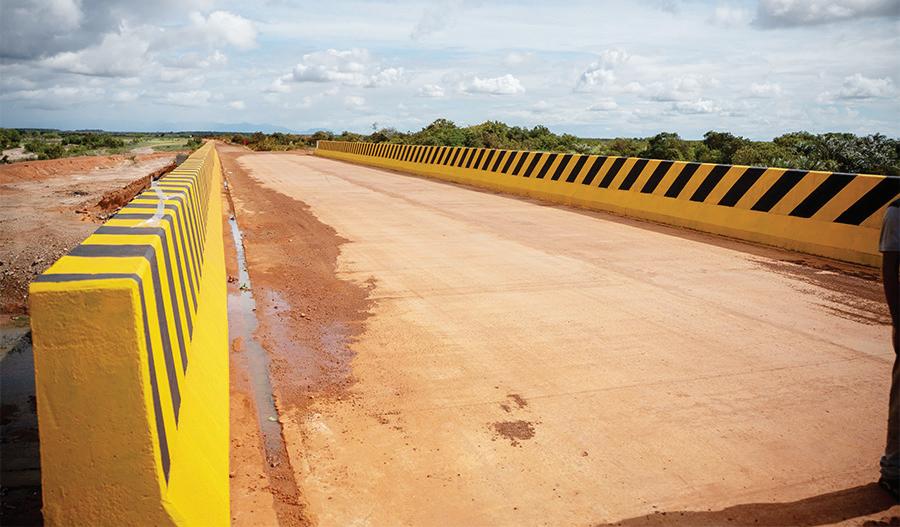
op our economic infrastructure, connecting businesses, schools, hospitals, farms, and families.” More than $12.9 billion is allocated for the corridor in 2025, while a total of $209 billion has been earmarked nationally to advance roads and bridges. Complementary projects underway across the country include the Linden to Mabura Hill Road, new bridges over the Corentyne, Berbice, and Demerara rivers, and major highways linking communities from Palmyra to Moleson Creek and Ogle to Eccles.
“These projects are the firm foundation of a fully connected Guyana,” Prime Minister Phillips affirmed.
“We are bridging our future by creating access and opening up opportunities.”
He also underscored the broader transformation unfolding under the PPP/C Administration, referencing Guyana’s record-breaking 43.6% GDP growth in 2024 and a 13.1% expansion in the non-oil economy—achievements driven by deliberate policy and people-centred governance.
“We are seeing the effects already—Guyana is now among the fastest-growing economies on Earth. But
we’re not letting that growth pass by our people—it is reaching them through roads, homes, jobs, and better wages.”
In reinforcing the ruling administration’s commitment to inclusive development, the Prime Minister also pointed to major investments in Amerindian communities, including the disbursement of over $9.5 billion from carbon credit revenues to fund more than 800 locally-driven projects.
“Regardless of where you live in this country, every child deserves the same chance, every business must have the same access, and every family must have the same hope.” He also credited the leadership of His Excellency, President Dr Mohamed Irfaan Ali, for prioritising infrastructure development as a tool for sustainability, job creation, and national transformation.
“In every region, our promises are all coming to fruition. This is progress with purpose and as we move forward, we are ensuring that no one is left behind.” The commissioning was attended by regional officials, engineers, community leaders and residents.

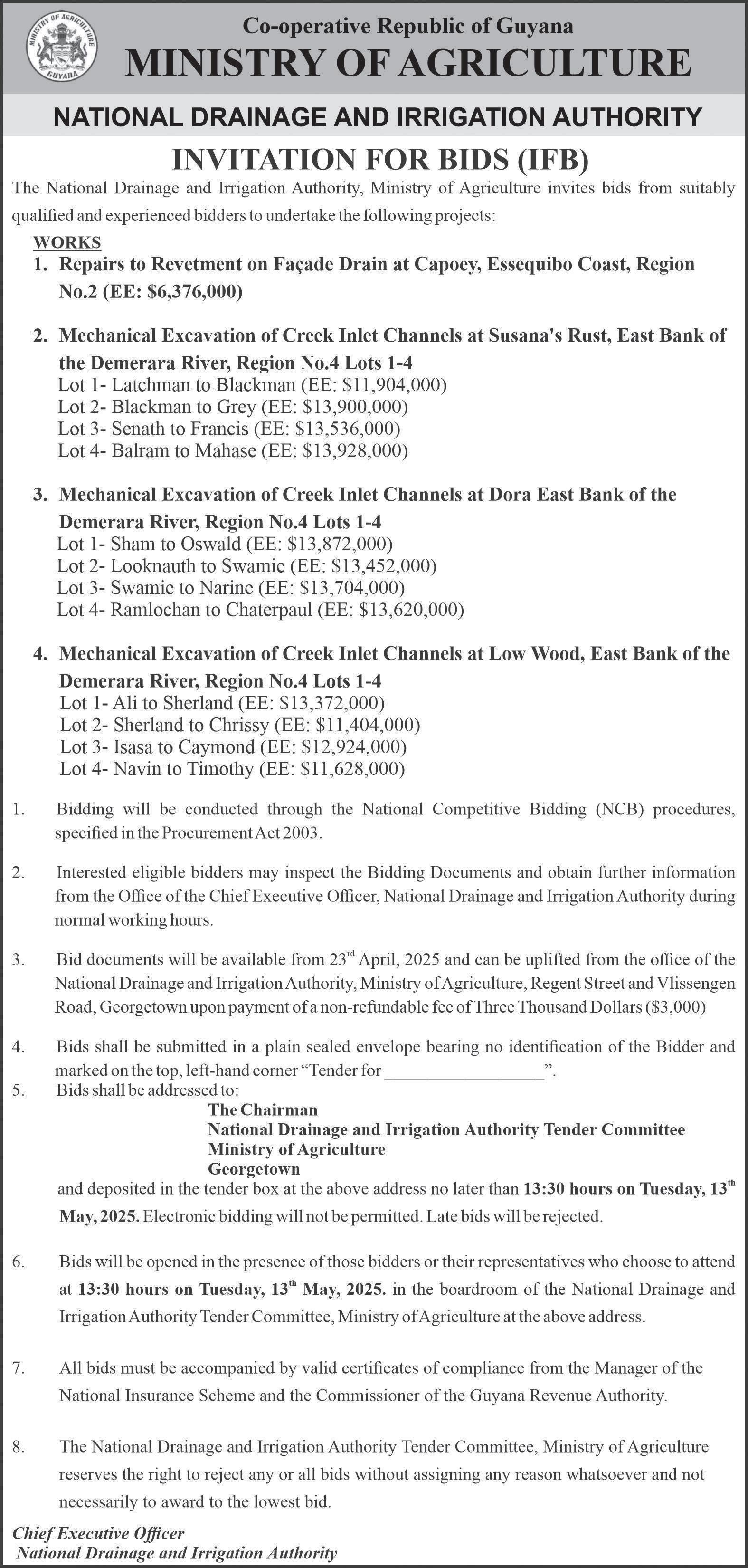
By Bebi Shafeah Oosman
IN the heart of Letterkenny Village, Region Six (East Berbice-Corentyne), two families are finally seeing the light of hope after decades of hardship and despair. For years, they endured challenging conditions, often living without basic amenities and struggling to make ends meet.
However, thanks to President Irfaan Ali’s Men on a Mission (MOM) initiative, the lives of these families are about to change forever, with the gift of a new home – an announcement that was
made in time for Easter.
For 58-year-old Khemwattie Latchanna, a parttime worker, the promise of a new house is more than just shelter—it’s a dream she never dared to believe would come true.
Living in a crumbling wooden structure with her 63-year-old husband who recently suffered a stroke, two of her sons, a daughter-in-law and three grandchildren, Latchanna has endured countless sleepless nights, especially during the heavy rains that flood her already fragile home.
She explained, “The house very bad, right now we deh downstairs a stay



the whole place a leak, is a wood house and we live here for 38 years.”
After receiving news from the Regional Vice Chairman, Zamal Hussain, that MOM would commence construction of a new house for the family, Latchana said, “I’m so glad for that, to receive a new house,” her voice quivering with emotion.
“I never expected to get any kind of help with the house… But one time the Vice Chairman did come for meeting and I make up my mind and go ask because long me been want ask and then he come back and check the house and now he come tell we that they will build it.”
Her words, though simple, carried the weight of years of silent suffering and unwavering resilience. Describing her living condition when it rains, the woman said, “Bare mud, like right now,
bare mud when it rain but me a try make much, me get one lil piece downstairs and me a try with it.”
Latchanna and her family expressed gratitude to President Ali. “We are thankful for the President because me a do ten-day work and me thank God for that because right now me na know what me would a do if wasn’t for that, so me thank the President, this is we government, we thankful to the President.”
Her husband, 63-yearold Subindranauth Kissoon was brought to tears as he expressed his gratitude. With his hands folded in humility, he spoke from the depths of his heart, stating, “I have always voted for him… and now I am receiving help. Thank you for that assistance. May I continue to have strength and health to support him.”
Meanwhile, not far away, Basmat Lakraj, a resilient mother of four, is also set to receive a brand new home. For years, she and her children have been living in a deteriorating structure.
The unsafe conditions and daily discomfort have taken a toll on the family, yet Basmat has remained hopeful. Now, through the MOM initiative hope is being realised. Her new home represents more than just shelter—it’s a fresh start, a safer environment for her children, and a renewed sense of stability that she has long dreamed of.
“The house na good, the whole place is leaking, the flooring na good, I poor, poor and all my
children going to school so it's very hard.”
Lakraj explained that due to her situation, she had to “give away” one of her children. “Me na get enough space and me give somebody and he deh better so me left he there.”
Her children are ages 15, 13, 9 and 8, and she noted, “We na get water, we na get light, we na get nothing so me very glad for this help… God go bless Irfaan Ali… Right now all abbay a sleep in one room because me children them bed a wet.”
The ir stories are powerful reminders that sometimes, help doesn’t just rebuild homes—it restores dignity, peace, and the will to go on.
The Regional Vice Chairman shared that after thorough assessments of both households, construction is now scheduled to begin, with an estimated cost of nearly $5 million.
“His Excellency President Ali, through this initiative, has been doing an excellent job. These are not just buildings, these are lives being rebuilt,” he said as he pointed out that houses are being built countrywide for vulnerable families through the MOM Initiative.
As the sun rises over Berbice for Easter this year, it brings with it more than just warmth—it brings hope. And through the compassion and action of initiatives like Men on Mission, that hope is finding its way into the hearts of those who need it most.
By Shaniya Harding in Bartica
BARTICA, often referred to as the gateway to Guyana’s interior, is buzzing with activity as the township prepares to welcome an estimated 10,000 people for the grand culmination of Regatta 2025. The highly anticipated event, which stretches across several weeks and concludes this Easter weekend, is a successful collaboration between the Bartica Town Council, the Ministry of Tourism, and the Guyana Tourism Authority.
Speaking to the Sunday Chronicle, Williams stated, “We want to especially thank our sponsors, as usual. They've come on board in ways that I can't imagine. We've started since April 5th, and there have been so many events that I've lost track. We're doing excellently well in terms of participation, in terms of the community coming together as one.”
The regatta season, which includes water sports, pageants, cultural shows, and family-centred activities, has long been a staple in Bartica's social calendar. But in recent years, it has taken on added significance as more Guyanese, as well as foreign tourists, include the event in their holiday travel plans and
Now one of the premier tourism attractions in Region Seven (Cuyuni-Mazaruni), Bartica Regatta has grown beyond a mere entertainment spectacle. According to Regional Chairman, Kenneth Williams, the event plays a major transformative role in the local economy, creating opportunities for small businesses and increasing the township’s appeal as a top tourism destination.
itineraries.
“I'm pretty satisfied with the reports that I've gotten that we are seeing an improvement in terms of this particular season. The season always opens the door for vendors or small businesses to benefit. It also encourages the local businesses and hustlers as well,” Williams said.
The ripple effects of the Regatta stretch across the town and local communities. Local hotel occupancy surges, restaurants see longer lines, and street vendors set up stalls to sell everything from local cuisine and souvenirs to crafts and clothing. It is, as Chairman Williams describes it, the town’s biggest economic opportunity of the year. The influx of visitors also provides an opportunity to showcase the region’s natural beauty, from its gold-mining history and riverine landscape to its warm,



Regional Chairman, Kenneth Williams (Japheth Savory photos)
welcoming culture.
Williams acknowledged the financial and logistical support received from the Ministry of Tourism, noting that while the funding might not always be sufficient, it immensely helps to keep the festivities vibrant and well-organised.
The Bartica Regatta has also become a model for regional tourism development, showcasing how community-driven events, when supported by national institutions, can uplift local econo -

mies and preserve cultural traditions. It also reinforces the government’s broader tourism goals, especially as Guyana continues to position itself as a unique destination offering a mix of adventure, heritage, and eco-tourism experiences.
With weeks of activities already underway, Easter weekend is projected to be the high point, with the Miss regatta pageant, mega show and boat races all slated for the three-day weekend.
The regional chairman underscored the town’s readiness to host the influx, stating that, “We anticipate a bigger crowd this year. We get 10,000 people. That is what we anticipate, usually, and that fits on the beach.”


By Naomi Parris in Lethem
LETHEM came alive once again as the annual Rupununi Ranchers Rodeo brought thunder to the savannahs during the Easter weekend.
This highly-anticipated event, which showcases the skills and traditions of the region's ranchers and vaqueros, drew thousands of spectators, from locals to tourists eager to witness the raw talent, daring feats, and cultural pride of Guyana’s ranching communities.
From its modest beginnings decades ago, the Rupununi Rodeo has evolved into a major national event, showcasing not just the skills of cowboys and cowgirls, but also celebrating the vibrant traditions of the country’s Indigenous Peoples.
With the midday sun blazing, the rodeo officially began on Saturday


with a parade through the capital town, setting the tone for a weekend filled with thrilling action and unforgettable moments.
Traffic along the main roads of the town came to a halt as horseback riders led a parade to the Triple ‘R’ Rodeo Ground, where the action happens. Patrons lined the streets and
followed suit, braving the elements for the weekend’s premiere event.
THE CHAOS BEGINS: WILD-COW MILKIN’
The festivities got off to a rip-roaring start with the ever-entertaining wildcow milking competition. It’s as wild as it sounds; teams of brave cowboys wrestled untamed cattle
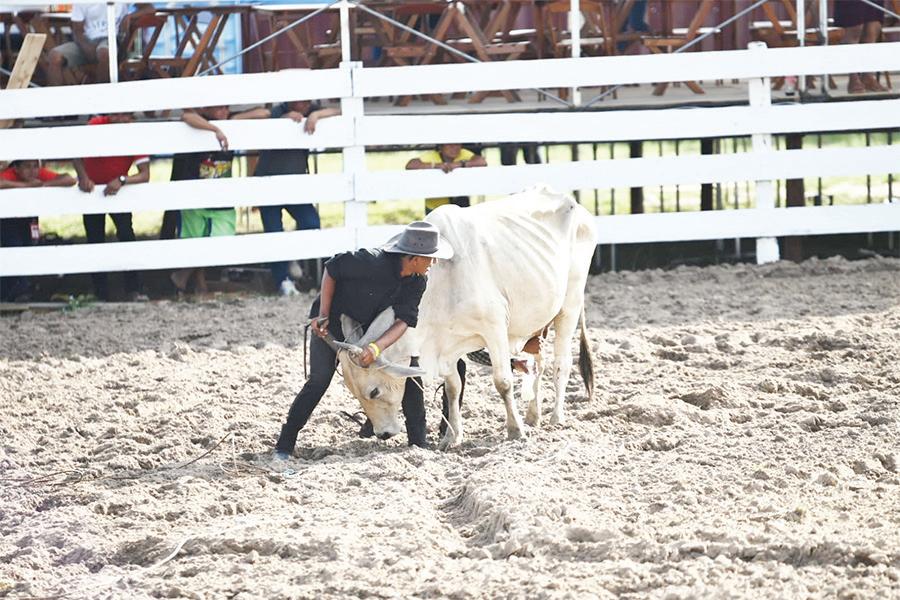


in a bid to extract even a splash of milk into their respective pails.
The event is messy, unpredictable, and downright hilarious, but it also requires remarkable coordination, fearlessness, and grit.
For many, it’s a fitting opener that captures the spirit of the rodeo: Raw, real, and rooted in ranching tradition.
Among the standout events was the ribbon-roping competition, a crowd favourite for its high-energy and collaborative challenge.
Here, the cowboys ‘lasso’ the charging cattle while their female teammates perform the daring task of retrieving ribbons tied to the animals’ thrashing tails. It’s not just a test of speed and skill, but of
pure nerve and flawless timing.
“Hold on to your hats!” became the unofficial slogan as the crowd watched with bated breath. The teamwork between the cowboys and cowgirls was on full display, highlighting the essential role that both cowboys and cowgirls play in Rupununi ranch life.
With each successful ribbon grab, cheers erupted from the grandstands, celebrating not just the success of the competitors, but the unity and heritage of the region.
The rodeo features a full slate of traditional and modern rodeo activities, from bareback riding to bull riding, and even competitions for children.
It’s a true family event, with something for everyone, from adrenaline junk-
ies to cultural enthusiasts.
But the rodeo isn’t just about the thrills. It’s a chance for Rupununi residents and visitors alike to reconnect with a way of life that’s deeply intertwined with the land. Traditional foods, music, dances, and crafts are showcased throughout the weekend, offering a complete cultural immersion into the ranching lifestyle of southern Guyana.
ECONOMIC AND TOURISM BOOST
The event has become a cornerstone of Guyana’s unique tourism experience, attracting visitors from across the country and neighbouring Brazil. Hotels and guesthouses in Lethem see full occupancy months in advance, while local vendors benefit from the influx of visitors.
According to the Chairperson of the Rupununi Livestock Producers As -
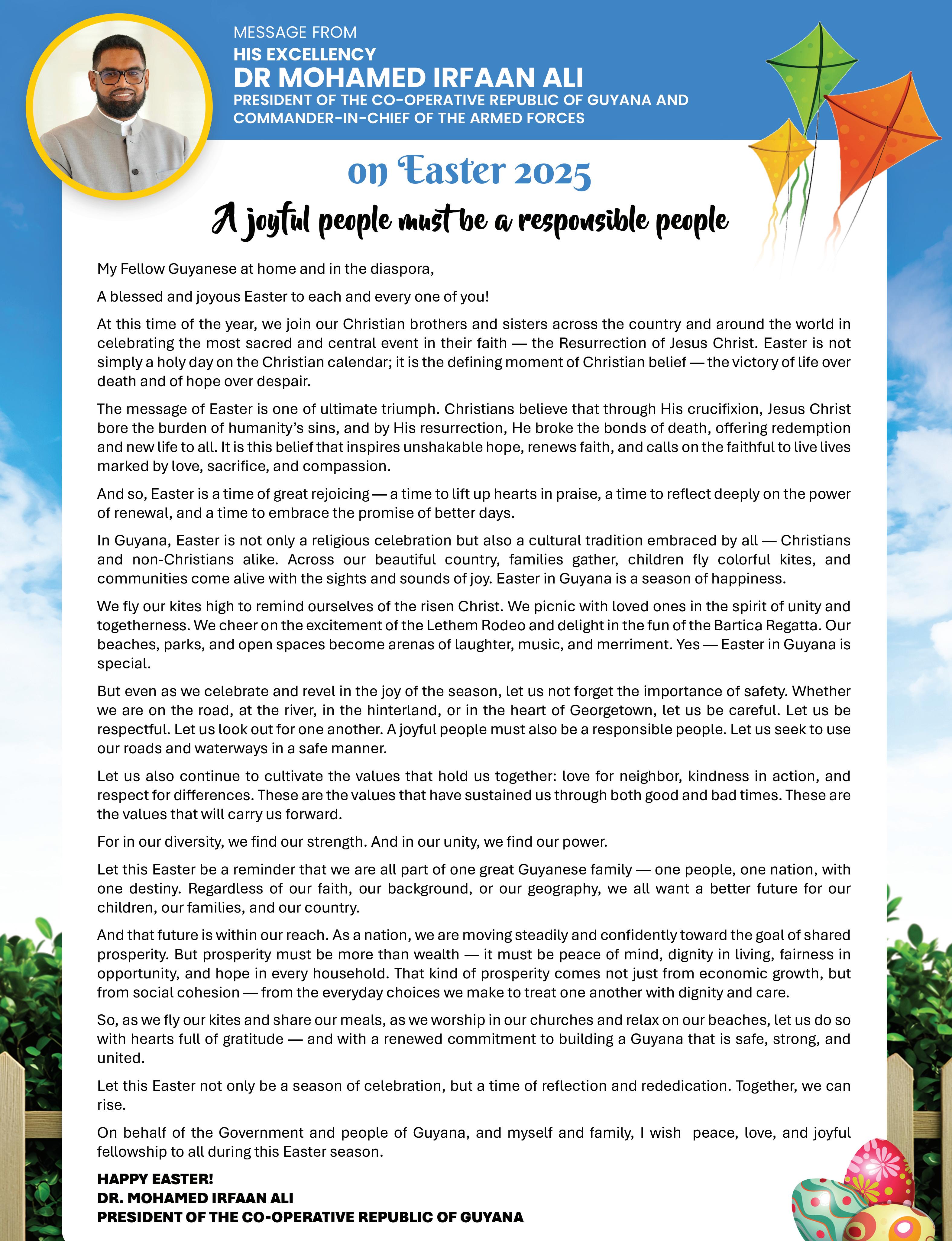

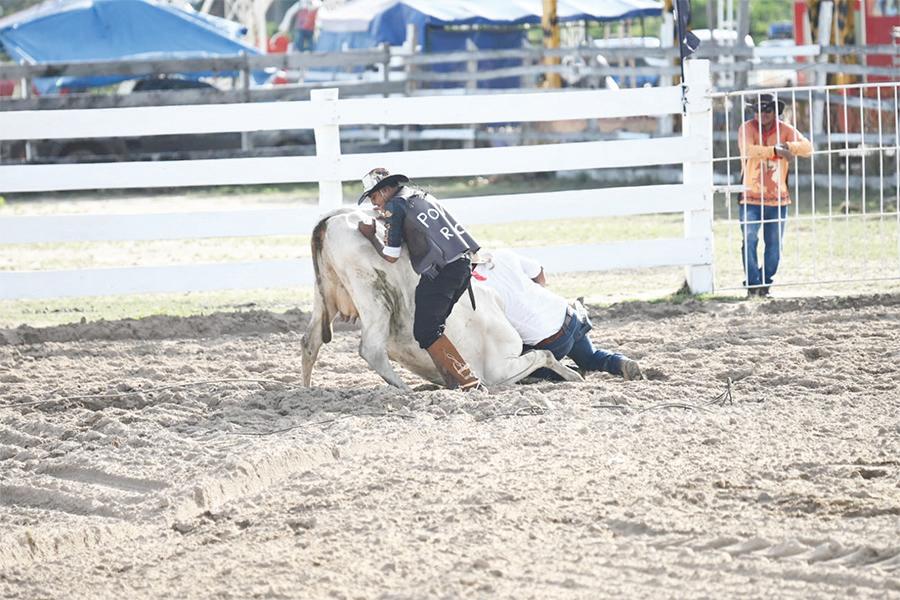


FROM PAGE 18
sociation (RLPA), the organising agency of the Rodeo, Kyle Joseph, the event contributes significantly to local economic development, and provides a platform for small businesses to thrive.
“There has been so much happening, like construction-wise, people putting together their businesses, people advertising their new tour packages,” Joseph told the Sunday Chronicle.
The rodeo is not only bigger each year, but also more polished, offering improved facilities and newer activities without losing its grassroots charm.
“It’s far-reaching,” Joseph said, noting that the rodeo is now mirroring major festivals like Coachella.
Back in 1952, locals began casually gathering at the Tabatinga airstrip to race. Over time, larg-
er groups of residents started organising annual roundups. These events gradually evolved, eventually giving rise to the rodeo tradition that continued to grow and develop through the years.
The Rupununi Ranchers’ Rodeo is more than an event; it’s a living testament to the endurance, pride, and vibrant culture of Guyana’s ranching communities. As the dust settles, and the cattle calm, what remains is a deep sense of respect for the ranchers who keep this legacy alive, year after year.
Whether you’re drawn by the thrill of the chase, the rich cultural expression, or the bonds of community that unite the savannahs, one thing is clear: The Rupununi Rodeo is an experience like no other. And if you missed it this year, just know, it’ll be even bigger next time.

By Feona Morrison
CALL centre jobs are not dead-end occupations; they offer limitless opportunities for growth, skill development, and economic independence. That was the message from Senior Minister in the Office of the President with responsibility for Finance and the Public Service, Dr. Ashni Singh, as he addressed scores of young people last Thursday at the launch of V-Chart Services’ third call centre in Guyana.
“You may have stepped out of the workforce because you became a mother, or had to take care of an elderly parent…Or maybe you wanted to take a break, or you lost your job and may be returning to the workforce now. These jobs are not just for the young; they’re also for the not-soyoung.”
Dr. Singh emphasised that Guyana’s rapidly growing Business Process Outsourcing (BPO) sector is not a collection of stagnant positions but an evolving
to see it for what it is—a platform for growth and development.
"If you apply yourself— you come, you work hard, you demonstrate productivity. You are disciplined. You are punctual; you work your full hours. You do good-quality work; you pay attention. There is no limit to what you can achieve in this industry,” he said.
Dr. Singh also underlined the value of the skills gained through call centre work, which he described as valuable and transferable.

The event also included a job fair. Speaking to a room filled with prospective employees, company executives, and government officials at the new Enmore, East Coast Demerara (ECD) facility, Dr. Singh passionately defended the role of call centres in transforming lives and building careers.
“There’s a reason why I spoke about the emergence of an industry,” he said.
“Because the reality is that this may very well be your first job. For young people who have just left high school and are trying to get some experience, earn an income, or figure out what they want to do for the long-term, this is an excellent starting point.”
He explained that the significance of the call centre industry goes far beyond first jobs. For many people, particularly women, call centres present a chance to re-enter the workforce after years away.
industry that provides multiple paths for advancement.
He reasoned: “You can come in initially as an operator– an entry-level operator– but if you’re very good, you can become a team lead. You can move up to a supervisor, shift manager, and eventually even become a manager. There is no limit to how you can grow in this company and the industry.”
"I have seen people start as an operator and become the owner of their own call centre. I have seen people start as operators and become the country manager of an international call centre. I've seen many people who started on the floor as an operator and became the country manager for major multinational companies,” Minister Singh posited.
He called on those working in or considering entering the call centre industry to abandon the misconception that the job is menial or without long-term value. Instead, he urged them
petitive workforce for international companies like V-Chart.”
As Singh concluded, “We want to create an environment where jobs are created, incomes are generated, and people’s lives are improved.” The opening of V-Chart’s third call centre comes at a time when Guyana is working to diversify its economy beyond oil and gas, placing greater emphasis on service industries, technology, and sustainable job creation.
The Public Service Minister called on everyone present to play a part in spreading awareness of the opportunities available.
“I want you to encourage as many young people as possible to come—and not just the young. You may have an aunt, or a mother, or an older cousin—an older cousin that you know is not working—and you can tell them that there is an opportunity, and you learn new skills too,” he said.
In closing, the Finance Minister urged workers to see their roles not just as jobs, but as stepping stones to something bigger. V-Chart Services is a fast-growing and dynamic company that specialises in Durable Medical Equip-

Senior Minister in the Office of the President with responsibility for Finance and the Public Service, Dr. Ashni Singh
town and Tuschen, located on the East Bank of Essequibo (EBE). Together, these two locations employ more than 160 people.
The India-based company, which began operations in Guyana in 2023, is aiming to hire approximately 250 individuals for its new facility in Enmore.
Since returning to office in August 2020, the People's Progressive Party/Civic (PPP/C) government has taken key steps to boost the BPO sector. These include liberalising the telecom -
supply.
“You develop proficiency in information and communications technology, customer relations, and communication with international clients. And of course, you develop other proficiencies,” he noted.
He explained that the training also includes proprietary knowledge, unique to the specific services V-Chart Services provides to its global clients—giving employees even greater value in the marketplace.
“So, you are also acquiring skills that will serve you well in terms of working on future opportunities,” he added.
Underscoring President Dr. Irfaan Ali’s commitment to job creation, Dr. Singh said that expanding employment is one of the government’s top priorities.
“President Ali has committed that we [the government] will spare no effort in ramping up our training and investment in young people… to ensure a com-
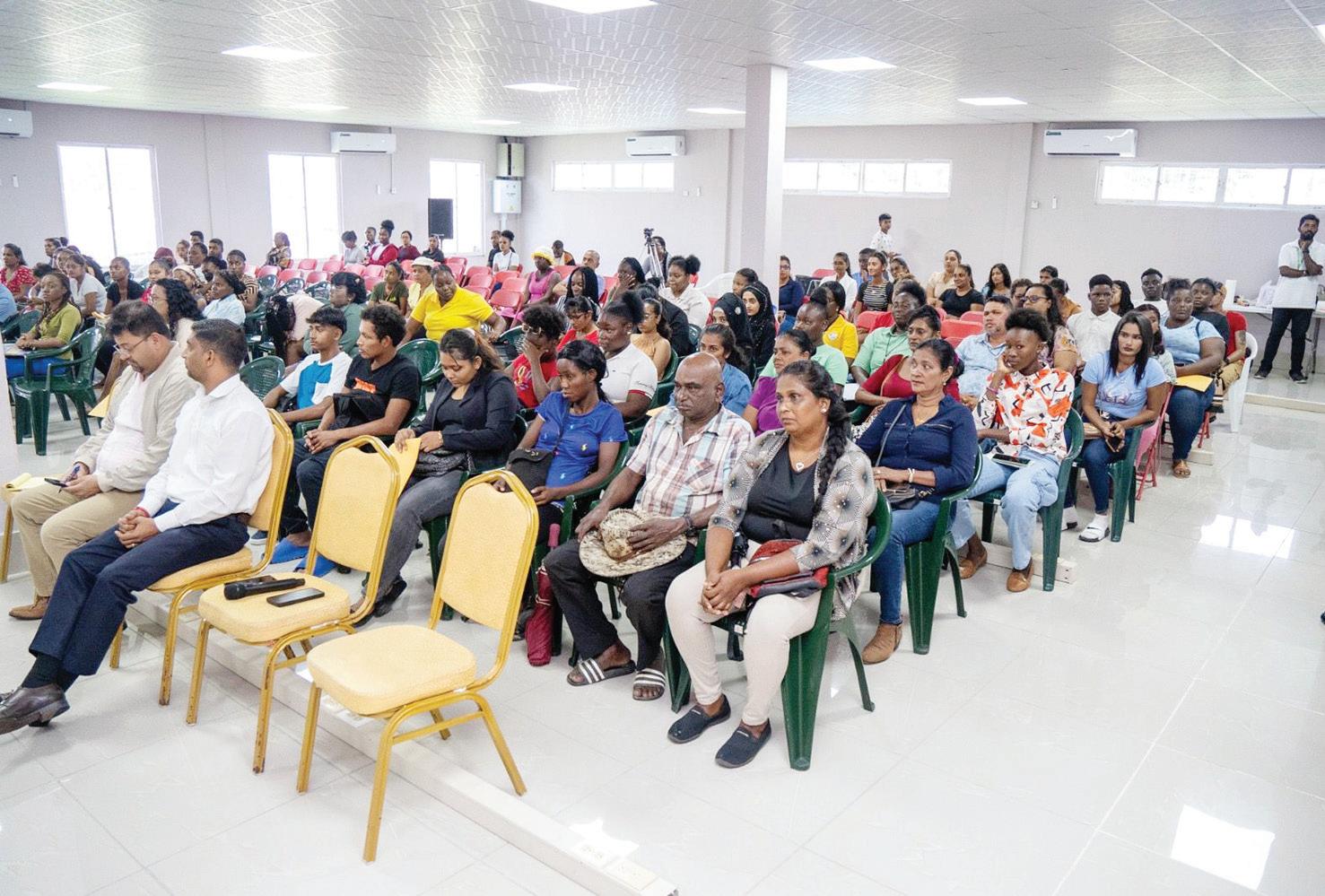
Prospective employees engage recruiters and explore career opportunities at V-Chart Services’ job fair
ment (DME) billing, for which it has become one of the market leaders, catering to major players in the United States healthcare sector.
V-Chart Services operates call centres in George-
munications sector--identified as a critical enabler for BPO and Information and Communication Technology (ICT) growth. The government has also been investing in infrastructure to support reliable power
Notable energy initiatives include the deployment of power ships in Berbice and Demerara and the Gas-to-Energy Project, aimed at doubling electricity generation and cutting electricity costs by 50 per cent. Guyana’s growing BPO sector is evidenced by the presence of Teleperformance, a French multinational call centre and customer service company that has established operations locally, generating new employment opportunities and driving sectoral growth.
With approximately 410,000 employees worldwide, Teleperformance is considered one of the largest BPO companies globally.
(FAO) - IN the quiet forests of Nepal's Nawalpur District, a revolution is taking root with the most unlikely tools -- cutters and compost heaps. A group of women in Binayi Triveni are turning what was once one of the region's greatest threats into a promising economic opportunity.
At first light, Meena Poudel, 41, bends low beneath the spindly canopy of Sal and Beech trees, her hands rustling through the forest floor's quilt of crisp, bronze-dusted leaves. Their edges are brittle and sunscoured, curled inward like sleeping insects.
Around her, other wom-
en move with quiet coordination, slicing through the bramble and deadwood with blades dulled from daily use. The forest breathes easier with each sweep— the tangled underbrush that once fed wildfires now gathered for something new: a slow alchemy into organic fertiliser.
Meena’s work has not only built a thriving local economy but has also contributed to a 70 per cent reduction in forest fires over the past year. What began as survival has become stewardship, and a local economy built leaf by leaf.
"By removing unnecessary material from the forest floor, we have sig-
nificantly reduced the risk of fires,” she says. “With fewer fires, the environment has become cleaner, which has also had a direct positive impact on human health. “Additionally, the bio-fertilisers we produce after processing the material are ‘organically pure,’ making them safer for human health and more suitable and environmentally friendly.”
Serving as Secretary, Meena manages the dayto-day operations of the Binayi Community Forest User Group, a community collective dedicated to responsible management of the forest. What she and her colleagues are doing

represents a fundamental shift in how communities approach environmental threats.
Rather than treating forest fire prevention as merely a defensive measure, they've created a proactive business model that converts risks into opportunity. Their business now produces over 60 000 kilograms
tiliser. The final stabilised product not only provides essential nutrients to plants but also helps restore soil health and microbial biodiversity—key factors in maintaining and improving long-term soil fertility.
This seemingly simple process has profound implications. The organic fertiliser they produce helps

to draft a business plan, conduct market analysis and meet product quality standards. Participation in cross-sectoral meetings helped the women navigate local bureaucracy and build alliances with nearby communities. These combined efforts transformed the group from informal volunteers into credible entrepreneurs.
Farmers in the region, increasingly wary of the long-term effects of chemical inputs, have turned to Binayi’s organic alternative. Many report not only healthier crops, but also better soil texture and fewer plant diseases. One farmer tested three different fertilisers on the same plot—only Binayi’s compost produced consistent, vigorous growth throughout the season.
annually, with ambitious plans to more than double production to 125 000 kilograms.
The branches— collected themselves or purchased from local women for two rupees—enter a carefully managed processing cycle. Once collected, the biomass is fed through a cutter that shreds the branches and bushes into smaller pieces, accelerating decomposition.
After shredding, the biomass is methodically layered—balancing dry and green materials to ensure optimal conditions—and placed in long, narrow piles known as windrows, which allow organic material to decompose naturally in the open air. The piles are regularly turned to introduce oxygen, while moisture and temperature levels are closely monitored to maintain microbial activity and ensure efficient breakdown over a period of about 90 days.
To enhance the process, agriculturally beneficial native microorganisms are added, transforming the compost into an environmentally friendly biofer-
local farmers transition away from chemical inputs, improving soil health and crop yields across the region. And perhaps most significantly, the business now provides income opportunities for 400 people in an area where employment, particularly for women, has been scarce.
The transformation from forest fire risk to enterprise began with local action, but it gained momentum through coordinated support. Investment followed effort. The local municipality matched the group’s initial capital.
In 2023, the Forest and Farm Facility (FFF) of the Food and Agriculture Organisation of the United Nations (FAO) provided USD 25 000 in catalytic funding. The FFF began by conducting a readiness exercise to assess the group’s potential, then supported training in forest management, composting techniques and market-based value addition. These steps helped ensure the enterprise was not only environmentally sound, but also economically viable.
They received support
The enterprise’s impact ripples beyond the forest. Women who once depended on others now fund their children's education. Meena now pays for her son’s bachelor’s degree in Kathmandu, while continuing to manage her household and lead the business from home.
Now, Meena says, their work i s not just about building their own capacity—but lifting others. “It is not just about developing our own capabilities but also about teaching and empowering others,” she says. “We are actively working to enhance their skills, connect them to the industry and bring more women into leadership positions.”
They are not finished. The forest stretches far beyond their community, and they are not yet immune to fire. But each day, their movement grows—one handful of forest debris at a time, one more neighbour trained, one more nursery nourished. A women’s movement that started in one forest now touches six. Soon, they plan to work across 42, reducing forest fires and building economies along the way.

ILO Director-General, Gilbert F. Houngbo, shakes hands with His Excellency Dr. Mohamed Irfaan Ali, President of Guyana, during a formal meeting in Georgetown

ILO Director-General Gilbert F. Houngbo meets with Dr. Carla Barnett, Secretary-General of CARICOM
THE Director-General of the International Labour Organization (ILO), Gilbert F. Houngbo, has concluded a significant threeday official visit to Guyana. This is his first trip to the Caribbean Community (CARICOM) country since assuming office in October 2022.
The visit, held from April 6–8, 2025, was anchored by the 13th ILO Meeting of Caribbean Labour Ministers and served to strengthen the ILO’s longstanding partnership with the Caribbean region
Hosted under the theme “Decent Work for Resilience: Securing the Future of Caribbean Labour,” the high-level meeting brought
together Labour Ministers, senior officials, and tripartite stakeholders from across the Caribbean.
The event served as a vital platform for dialogue on key regional labour concerns, particularly in light of ongoing global challenges.
In his keynote address during the opening ceremony on April 7, 2025, at the Arthur Chung Conference Centre (ACCC), Houngbo emphasised the importance of inclusive collaboration and reaffirmed the ILO’s commitment to the Caribbean’s development agenda.
“The discussions here at this 13th Caribbean Labour Ministers’ Meeting will help us identify the priorities we must set and the strategies
we can adopt to effectively renew a new Social Contract as we prepare for the Second World Social Summit,” he said.
“I will stand with the Caribbean in ensuring that the realities of the subregion are prioritised within the ILO global agenda and beyond.” One of the major highlights of the Director-General’s visit was the signing of Guyana’s third Decent Work Country Programme (DWCP). The DWCP is a tripartite agreement aimed at promoting decent work through employment creation, social protection, labour rights, and enhanced social dialogue.
The signing, which took place in the presence of
TURN TO PAGE 24


FROM PAGE 23
Houngbo, was conducted by representatives from the Government, employers, and workers' organisations, with the technical and strategic support of the ILO.
Beyond the Labour Ministers’ meeting, Houngbo also paid high-level courtesy calls on two of the region’s leaders. On April 8, 2025, he met with President Dr. Irfaan Ali and Dr. Carla Barnett, Secretary-General of CARICOM.
During these engage -


ments, the parties discussed critical regional issues such as climate change, labour migration, digital transformation, and the urgent need for a just transition—ensuring that no one is left behind as the Caribbean adapts to global shifts in work, technology, and the environment.
The Director-General’s engagements throughout the visit reinforced the ILO’s support for regional cooperation, strengthened social dialogue, and highlighted the importance of ensuring
Caribbean perspectives are represented in global decision-making.
As the region prepares for the 113th International Labour Conference and the Second World Social Summit, this meeting serves as a crucial step in aligning strategies and amplifying the Caribbean’s voice on the world stage. The ILO continues to play a pivotal role in the Caribbean’s development journey, supporting labour standards, policy formulation, and inclusive economic
growth.
This historic visit to Guyana represents a renewed momentum in that partnership, as the region seeks to build resilience and ensure decent work for all. The ILO is a United Nations (UN) agency whose mandate is to advance social and economic justice by setting international labour standards. Founded in October 1919 under the League of Nations, it is one of the first and oldest specialised agencies of the UN.


Two men who admitted to killing their wives in separate domestic violence incidents are now awaiting sentencing at the Demerara High Court. Michael London, a former soldier, pleaded guilty to the capital offence of murder before Justice Simone Morris last week.
He admitted to killing his wife, 38-year-old Shaneka Elliot, who was stabbed to death on May 19, 2017, at Central Amelia’s Ward, Linden, Region 10. Elliot was reportedly attempting to end the abusive relationship when she was attacked. Reports indicate that London inflicted approximately 15 stab wounds on the woman, who was pronounced dead at the Mackenzie Hospital.
A post-mortem confirmed that her cause of death was multiple incise wounds. After committing the act, London fled the scene and was captured by police the same evening in the jungle of Moblissa, along the Soesdyke-Linden Highway. During the arrest, he reportedly resisted and attacked the police officers, resulting in him being shot in the leg.
Now that London has pleaded guilty, he is scheduled to be sentenced on May 8, 2025, following the court's consideration of victim impact statements,

a probation report, and other relevant reports.
In a separate but equally horrifying case, a man identified only as Gowkaran, pleaded guilty to the capital offence of murder for the killing of his wife, 47-year-old Debbie Singh, in 2020.
Gowkaran, 54, admitted before Justice Morris that on April 9, 2020, he deliberately set Singh on fire at their home at Meten-Meer-Zorg, West Coast Demerara (WCD). The incident took place in the presence of their then-oneyear-old twin children.
The state prosecutor presented the agreed statement of facts, which detailed how Singh was doused with kerosene and alcohol and set ablaze during a domestic dispute.
As the flames engulfed her body, Gowkaran reportedly restrained Singh, preventing her from escaping. Despite her injuries, she managed to break free and ran outside to seek help from a neighbour. Meanwhile, Gowkaran
locked himself in a room and attempted to take his own life by hanging. Police were forced to break down the door, after which they rescued him and placed him under arrest.
Singh sustained critical burn injuries and was later hospitalised at the Georgetown Public Hospital Corporation (GPHC), where she succumbed. A post-mortem examination determined that she died from pulmonary thromboembolism due to septic burns, further complicated by multiple acute gastric ulcers.
With Gowkaran now having pleaded guilty to the capital offence, his sentencing has been set for May 7, 2025. Justice Morris is expected to make her decision after reviewing victim impact statements, a probation report, and other relevant reports. Both London and Gowkaran remain in custody as remanded prisoners.
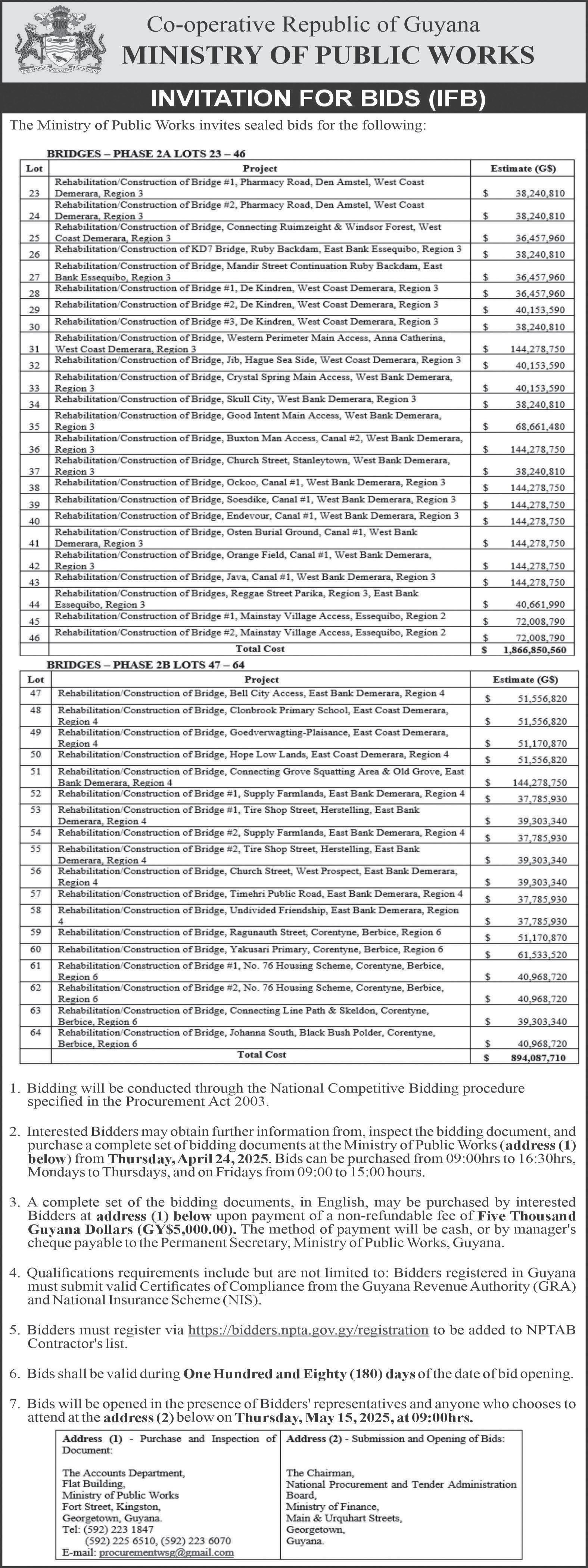
MINISTER of Agriculture, Zulfikar Mustapha, has announced significant progress in the expansion of the coconut
industry in Region Six (East Berbice-Corentyne), highlighting its growing contribution to the region’s agricultural development.
According to the minister, the cultivation area dedicated to coconut production has now reached an impressive 8,000 acres—a nota -


ble increase that reflects both government support and farmers’ commitment to diversification.
This expansion continues to boost local employment, enhance export potential, and provide opportunities for value-added products such as coconut water, oil, etc.
During an interview with the Sunday Chronicle, Minister Mustapha emphasised that the government remains committed to supporting the industry through continued investments. He pointed out that “the coconut industry has increased tremendously. We have increased coconut to date close to about over 8,000 acres already in this region; nationally, it's vast, almost 38,000 acres of coconut we have expanded in the industry.”
In Black Bush Polder last week, President Irfaan Ali revealed that the Ministry of Agriculture will be exploring the replanting of coconut as a way of boosting supplementary income for interested farmers, further contributing to agricultural diversification and economic resilience in the region.
According to President Ali, he also asked the Ministry of Agriculture to design a project where coconut trees can be replanted.
He said that with the provision of the Brazilian green nuts and about 5,000 – 10,000 coconut plants, a facility will be built that will purchase the nuts and bottle coconut water for the local and regional markets, in order to create more “opportunities for your income.”
“Those are the things that will help to increase your disposable income to diversify the earning potential of your land.”
As such, Minister Mustapha said that the directives from President Ali will assist farmers in expanding.
“As a matter of fact, we have a number of areas; we had two specialists that came from India who are now working with us, and we are looking at the banks, the Berbice River bank, Canje River bank.”
He added that in the Black Bush Polder area, the ministry is looking at another 500 acres for coconut production. “We are looking to develop some right in the Canje area with the single parents that the President talked about with the shade house programme.
According to Minister Mustapha, coconut farmers who are already cultivating will also receive the necessary assistance.
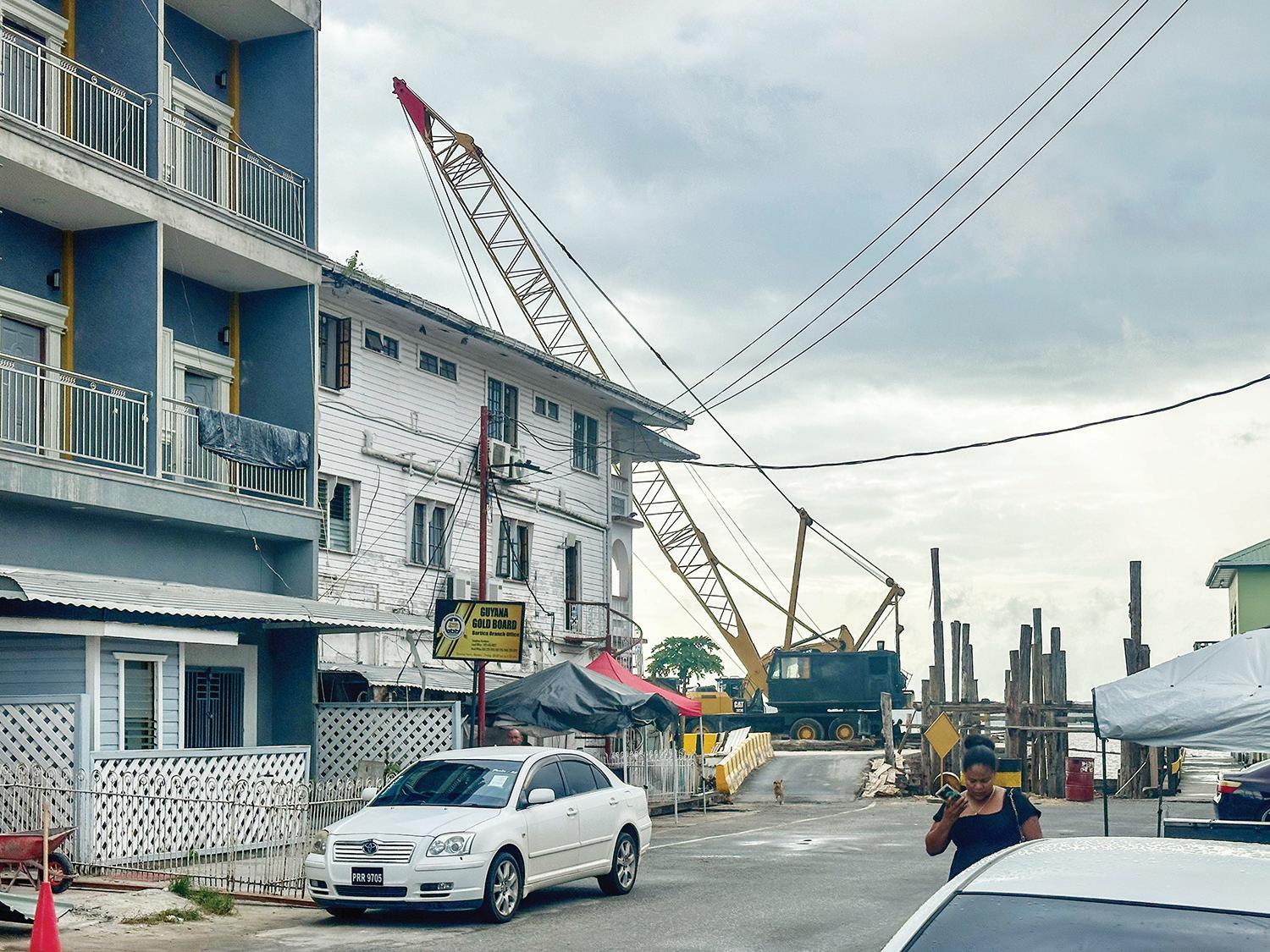
By Shaniya Harding in Bartica
Infrastructure continues to rapidly develop amidst the hustle and bustle of Bartica’s Regatta season. Speaking to the Sunday Chronicle on Saturday, Regional Chairman of Region Seven, Kenneth Williams, confirmed that long-awaited rehabilitation works on the Bartica Stelling are expected to be completed within the coming months.
“They are now completing a project that started sometime in 2017. And my anticipation is that it will be completed in a few months,” Williams said, expressing optimism about the project’s timeline.
The Bartica Stelling, a critical point of connectivity for residents and visitors alike, has undergone extensive repairs and upgrades in recent months. The rehabiltation efforts aim to improve safety, passenger comfort, and cargo handling capacity. Once completed, the rehabilitated facility is expected
to enhance transportation access and further enhance economic activities in the township, which has become increasingly vibrant with ongoing tourism events and infrastructural development. Meanwhile, construction of the 500 houses by the Ministry of Housing and Water is progressing steadily at 5 Mile, Bartica. This initiative, part of the government’s Dream Realised programme, reflects its broader commitment to regional development, job creation, and ensuring access to affordable housing.
Minister of Housing and Water, Collin Croal, during a community engagement last month, reiterated the administration’s dedication to revitalising the region’s housing sector. Since 2020, the ministry has re-engaged Region Seven with renewed energy. It initially resumed allocations in Bartica with 132 house lots. Currently, 55 homes are designated for the area, and several beneficiaries received their allocation letters during
the most recent outreach in March.
The Ministry of Housing and Water further reported that 20 persons have already prequalified for homeownership through the banking system, with more expected to benefit as the programme progresses. The initiative is part of the PPP/C Government’s broader national housing drive, which has seen the allocation of over 41,800 house lots and the establishment of more than 70 new housing areas countrywide. Of these, three are located in Bartica alone, signalling the administration’s commitment to balanced regional development.
The township is also seeing many infrastructural developments in other areas as well, with a brand new Citizen’s Bank to be completed in the coming months. With the dual momentum of improved transport infrastructure and large-scale housing development, Bartica continues to be a model for integrated growth and development.
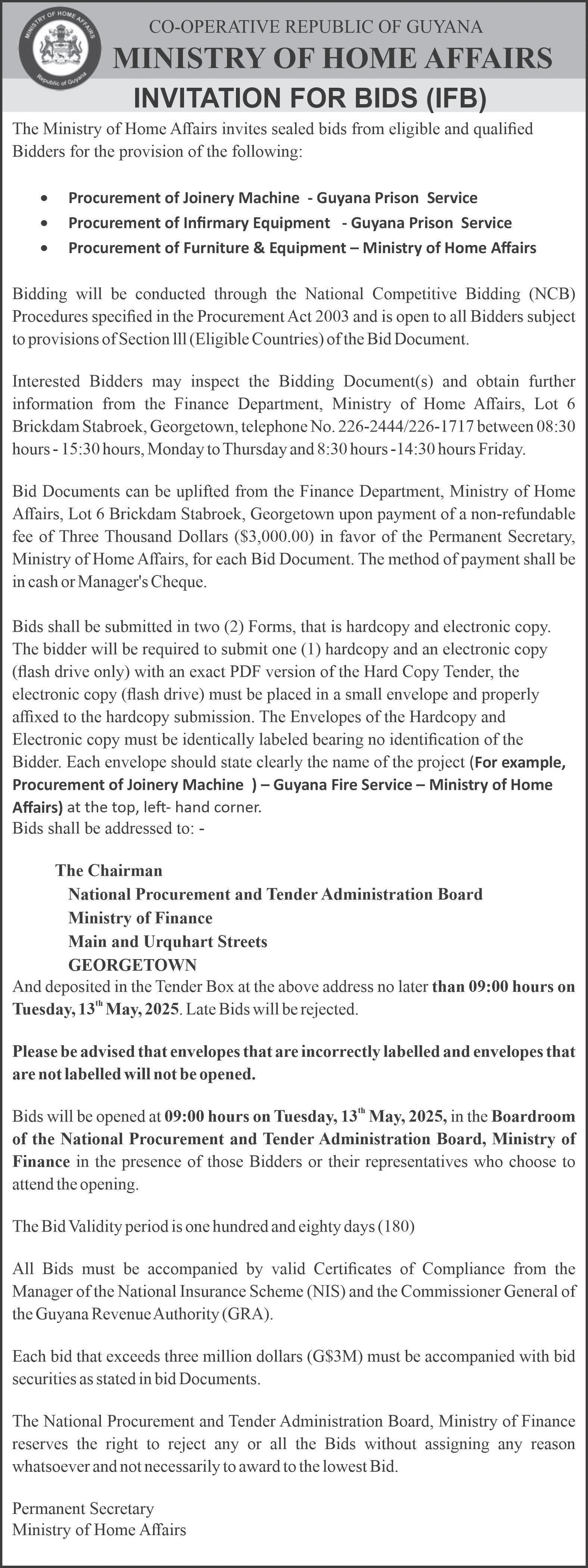
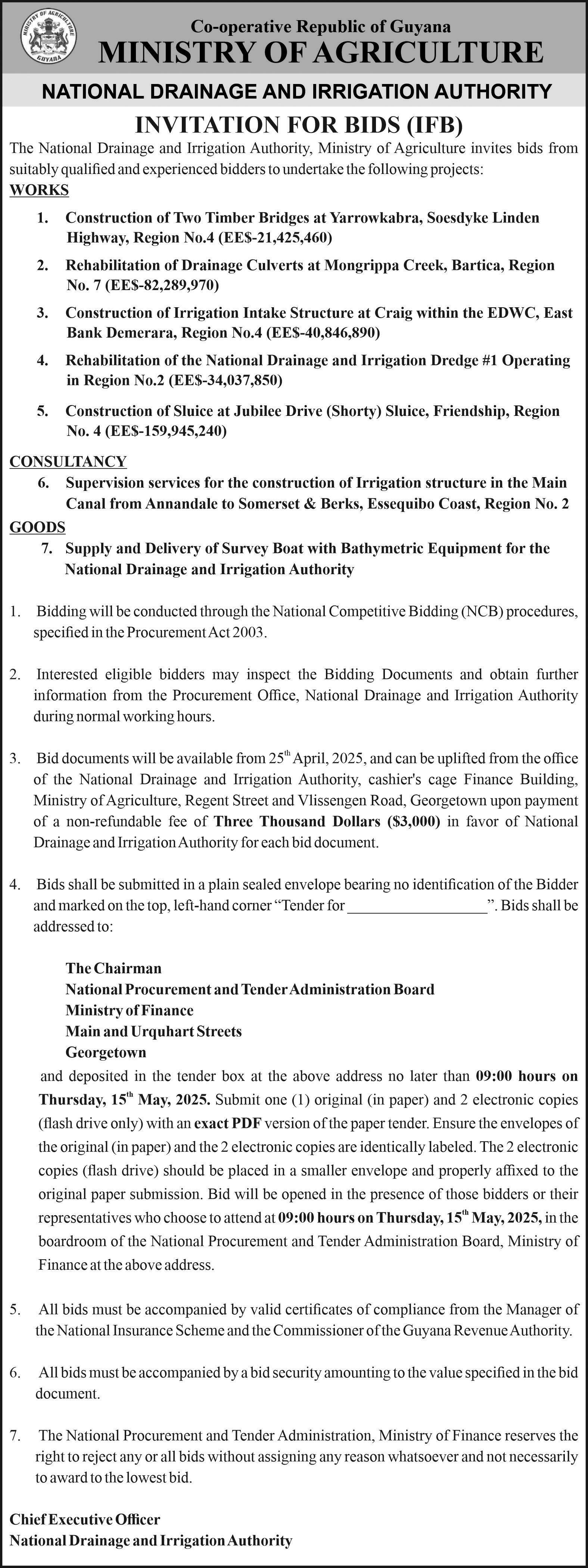






Aston Villa produced a sensational performance to beat Newcastle United at Villa Park and lay down a marker in the race for the top five and Champions League qualification.
Ollie Watkins became Villa’s joint-top Premier League goalscorer - alongside Gabriel Agbonlahor - on 74 when his shot took a wicked deflection off Fabian Schar after just 33 seconds.
Newcastle levelled in the 18th minute when Schar met Harvey Barnes’ deep, curling cross and headed through the legs of Villa keeper Emiliano Martinez.
But in the 64th minute Watkins sent in full-back Ian Maatsen who deservedly restored Villa’s lead with a cool dink over the goalkeeper.
Villa added a third in the 73rd minute when Jacob Ramsey’s pass across goal bounced in off Newcastle defender Dan Burn.
And a fourth came moments later through substitute Amadou Onana’s stunning strike which found the top corner from the edge of the box.
Villa’s convincing win lifts them to sixth in the table,
level on points with fifthplaced Nottingham Forest.
Newcastle remain third but are now just two points ahead of Villa with five games of the season remaining
spired by Watkins who twice hit the woodwork, clattering an effort against the underside of the crossbar at 1-0, and thumping a header against the post at 1-1.
In the second half Villa
result beyond doubt though. And shortly after they went 4-1 up, Ramsey nearly made it five but his shot struck the inside of the post.
Villa face fellow European hopefuls Manchester City

Villa Park is packed full of positivity these days. Unai Emery’s side have now won 10 of their past 11 games in all competitions to propel themselves back into Champions League qualification contention. Their first half was in -
always looked the likelier to score and John McGinn came close to putting them ahead but he was denied by Newcastle keeper Nick Pope when through on goal.
Three goals in 11 minutes from Maatsen, the unfortunate Burn and Onana put the
and Bournemouth in the runin but after beating a Newcastle team that had won six on the bounce, and scored 12 goals across their past three games, few would bet against Emery’s side reaching the Champions League for a second successive season.
AFGHANISTAN emerged victorious from a competitive Asia Qualifier on Saturday, landing top spot and becoming the latest nation to qualify for the ICC U-19 Men’s Cricket World Cup 2026 in Zimbabwe and Namibia by virtue of superior net run rate, with the final round of fixtures in Kathmandu abandoned due to rain Their campaign began with dominant eight-wicket wins against Oman and Hong Kong China, before a mammoth score of 359 for four helped them defeat the UAE by 180 runs (D/L) and put them into the driver’s seat heading into Saturday’s winner-takes-all tie against Nepal. With the hosts also enjoying an unbeaten week, fans had hoped to witness a dramatic conclusion to the competition; however per -
sistent rain meant no play was possible at the Lower Mulpani ground.
As a result, Afghanistan’s net run rate of +4.82 was enough to secure top spot from Nepal (+3.58) and deliver their ninth appearance at an U-19 Men’s Cricket World Cup.
The post-match celebrations, led by captain Mahboob Khan, also honoured top-scorer Khalid Ahmadzai - the wicketkeeper-batter taking home the Player of the Tournament prize with 202 runs during the week which included a stellar 132 in the win over the UAE.
Reacting to their qualification, Afghanistan’s skipper Mahboob said: “Qualifying for the World Cup is a dream come true. This is a proud moment for every Afghan. We played with heart, and today our hard work paid off.
“This victory is for our nation, for every young boy who dreams of wearing the Afghanistan jersey. We are going to the World Cup and it is just the beginning. We will continue to work harder, stay humble, and fight for glory on the world stage.
“In the end, I want to thank my teammates, coaches, and the entire support staff. We stood together in tough times, and now we celebrate together.”
As a result of the win, Afghanistan is the latest team to confirm its place among the 16 that will compete at next year’s ICC U-19 Men’s Cricket World Cup 2026.
Ten teams automatically qualified for the event as the best-placed Full Member nations from the previous edition in 2024. These are: Australia, Bangladesh, England, India, Ireland, New Zealand,
Newcastle never really clicked and were blown away by Villa’s energy.
Alexander Isak was well-marshalled by defenders
Tyrone Mings and Ezri Konsa and was pretty much limited to one tame, curling effort straight at Emiliano Martinez with the score at 1-1.
Tricky wingers Jacob Murphy and Harvey Barnes were likewise dealt with by Villa’s full-backs Matty Cash and Maatsen.
Assistant manager Jason

Tindall once again deputised for manager Eddie Howe who continues to recover from pneumonia. Their side could have gone eight points clear of Villa with a win. Instead their advantage over the Villans was cut to just two points.
Newcastle will hope to respond when they host Ipswich next Saturday, while Villa are away at Manchester City on Tuesday. ( BBC Sport )
Pakistan, South Africa, Sri Lanka and West Indies
Full Member hosts of the 2026 edition, Zimbabwe, has also secured automatic qualification.
The remaining five spots are determined through regional qualification pathways, with only the winning team from each Regional Qualifier advancing to the ICC U-19 Men ’s Cricket World Cup 2026.
Tanzania became the first team to qualify through this route earlier in the month by virtue of winning the Africa Qualifier, with Afghanistan now joining them as winners in Asia.
The focus now shifts to East Asia-Pacific, where Japan, Fiji and PNG will compete for their World Cup place in Sano, Japan from April 24-29. (ICC Media)
SUNDAY, APRIL 20, 2025
THE Miami Heat became the first 10th-seeded team to reach the NBA play-offs through the play-in tournament as they scored an overtime success against the Atlanta Hawks
The Heat began the fourteam Eastern Conference qualification tournament needing to win consecutive road games to advance.
After beating the Chicago Bulls on Wednesday, they followed up with a 123-114 overtime success over the Hawks to set up a first-round meeting with conference top seeds the Cleveland Cavaliers
In the Western Conference, the Memphis Grizzlies defeated the Dallas Maver-
icks 120-106 and will face the Oklahoma City Thunder in round one, with play-off games in both conferences beginning on Saturday.
Defeat marks the end of a miserable campaign for the Mavericks, which included their star Luka Doncic being traded to the Los Angeles Lakers and Kyrie Irving sustaining a season-ending anterior cruciate ligament injury.
Anthony Davis, who moved to Dallas as part of the Doncic trade, received medical treatment for groin and lower back injury problems throughout Friday’s game but still led his side with 40 points and nine rebounds.
The Heat had bounced back from a 10-game losing
streak last month to reach the post-season tournament and dominated the opening half
against the Hawks, leading by 17 points at one stage before taking a 62-53 lead into
the break. However, the Hawks stormed back and were 98-

THE much-awaited central contracts for the Indian team will be released soon and barring a few , there are unlikely to be too many surprises in the list. The Board of Control for Cricket in India (BCCI ) may make some concessions for a few promising players who may not totally qualify to earn the central retainership.
expected to be included in Grade C, that assures annual retainership of INR 1 crore.
As per the BCCI standard policy , “athletes who meet the criteria of playing a minimum of three Tests or eight ODIs or 10 T20Is within the specified period will automatically be included in Grade C on a pro-rata basis.”
Abhishek has featured in 17 T20Is in all and has played

Top of the list could be Abhishek Sharma, the promising left-handed batter from the Punjab and Sunrisers Hyderabad (SRH) teams. He is one of the finest cricketers in world cricket as well as the ongoing IPL currently. He is
in 12 T20Is in the specified period, which is generally from October to September.
Apart from Abhishek (24), Nitish Reddy is also in the running to be part of the central contracts list.
The 21 -year-old Andhra
all-rounder has played five Tests and four T20Is and should qualify to be in the list by virtue of having played the required number of Tests . For the record, he was part of all five Tests in the BGT series Down Under.
Similarly, there is a chance that Harshit Rana will also be included. Rana has played two Tests, five ODIs and one T20I and does not fulfil the criteria in any of the three formats separately. But cumulatively he has played a sufficient number of games to be in the list.
As previously reported, Varun Chakaravarthy (four ODIs and 18 T20Is) too should come into the list, as well as Shreyas Iyer, who was one of the star performers in the just-concluded Champions Trophy Rohit Sharma, Virat Kohli, Jasprit Bumrah and Ravindra Jadeja will continue to be A+ category and it is unlikely that there will be too many changes to the gradings - give or take twothree names.
The Contracts are expected to be announced in a couple of days along with the changes to the support staff of the Indian teams. The decisions are understood to have been taken recently. ( Cricbuzz )
92 up with five minutes and six seconds remaining.
A Tyler Herro free throw edged the Heat 106-104 up with 12 seconds left, only for Trae Young to score a late lay-up and send the game to overtime.
The Heat found their range from the perimeter in the extra period with Davion Mitchell sinking three three-pointers and Herro adding two more to secure the win.
“I loved how my team fought,” said Herro, who finished on a game-high 30 points. “Every single run that they made, we answered. And I feel like this entire season has really built us up for this point.”
BERBICE Under-17 players, Ramzam Koobeer and Sohaiil Mohamed are the latest young cricketers to benefit from Project “Cricket Gear for young and promising cricketers in Guyana,” the joint initiative of Anil Beharry of Guyana and Kishan Das of the USA.
Koobeer was the recipient of one cricket gear bag, one pair of thigh pads and one pair of batting gloves while Mohamed received one pair of wicket-keeping gloves with inners and one metal spike boots. The items were bought from funds donated by Nafico/Nalico. They both represented Berbice in the recently concluded Guyana Cricket Board Under-17 Inter County tournament
At a simple ceremony held recently, the aspiring stars expressed gratitude for the tokens and promised to continue to work hard on their cricket.
The initiative will continue to strive to make every community a safer and better place and is pleased to be part of the development of young cricketers in Guyana.
Total cricket related items received/purchased so far: $610,000 in cash, 13 coloured cricket uniforms, one set of stumps, two trophies, 34 pairs of cricket shoes, 37 pairs of batting pads, 46 cricket bats, 41 pairs of batting gloves, 28 thigh pads, three pairs of wicket-keeping pads, six arm guards, two chest pads, two boxes, 14 gear bags, 13 bat rubbers, seven helmets,
one fiber glass bat, one pair of floppy hat, 16 boxes and four boxes of white cricket balls, 13 boxes of red cricket balls, one bat cone and 28 footballs.
used or new, are distributed free of cost to young and promising cricketers in Guyana. Skills, discipline and education are important characteristics
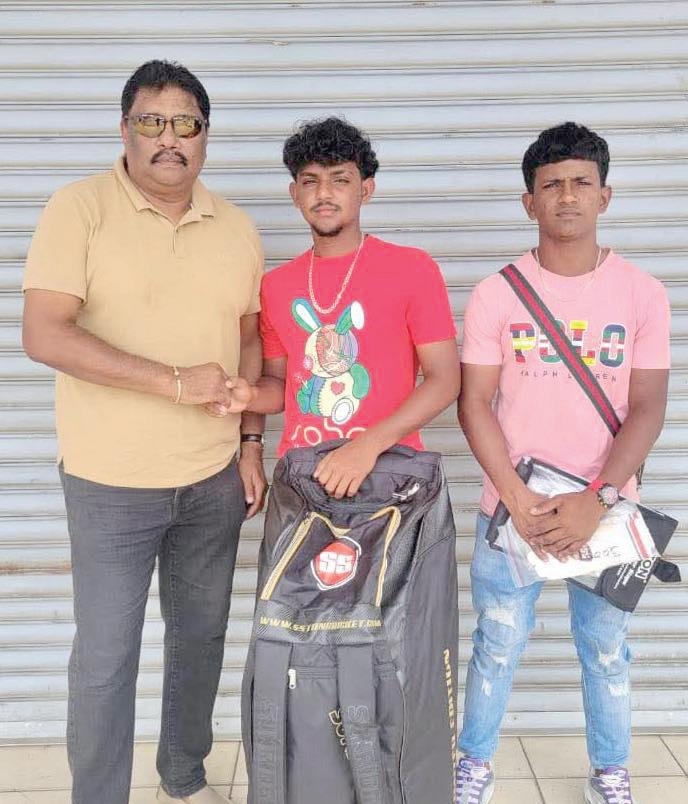
To date, 98 players from all three counties of Guyana have benefitted directly from cash, eight gear bags, two trophies, four arm guards, 35 bats, four boxes, six helmets, 36 pairs of cricket shoes, 21 pairs of batting pads, 26 thigh pads, one bat grip, 37 pairs of batting gloves, one pair of wicket-keeping pads and four pairs of wicket-keeping gloves Cricket related items,
of the recipients. Talent spotting is being done across the country and club leaders also assist to identify same. Progressive and well-managed cricket clubs with a youth programme, will also benefit. Anyone interested to contribute can contact Anil Beharry on 623 6875 or Kishan Das on 1 718 664 0896.
By Sean Devers
TEVIN Imlach was born on November 30, 1996, to Louis and Simone Imlach. He attended Rama Krishna Primary School, where he played his first ‘real’ cricket match and scored 59.
The 28-year-old West Indies Test player said that it was how his interest in cricket was ignited.
“I was in the newspapers for that performance. That is my earliest memory of playing competitive cricket.”
According to Imlach, he and his two sisters grew up in a tightly knit family with loving parents.
“I had a fun childhood growing up in Cummings Park, Sophia, where there were a lot of kids. We played cricket and football in the Streets. We used to go swimming…there was a Cane field not far from where we lived.
My sisters and both parents were always there for me… they played an integral role in what I am today. They worked hard to give us what we needed, and I am so proud of them for what they would have achieved throughout the years. Two hardworking people, dedicated to making the kids and their lives better.
It was a joyous time growing up in Sophia…I had a lot of friends,” Imlach remembered.
“As long as I can remember, I have always loved cricket. We played a lot of games growing up, and cricket was one of them.
I was good at it, one of my dad’s friends…Orin Bailey…he was a member of DCC and recommended that club, and that’s where it all started.
I joined Demerara Cricket Club (DCC) at age 11 and played Under-13. Cricket took over my life, and that’s how I developed into what I am today. Growing up, I played all sports in the Community.
I remember scoring my first hundred in a second division game at GYO,” posited Imlach In Multan this year, Imlach was the first Guyanese Test wicket- Keeper in Pakistan since
1962, when Ivor Mendonca played.
Milton Pydanna, who played in two ODIs in 1980, was the last Guyanese wicket-keeper to play in Pakistan.
Imlach never played U-15 or U-17 cricket for Guyana and was not a wicket-keeper.
“I started keeping in my last year at U-19. I have always had good hands, catching in the slips…I was a good fielder.
as Guyanese who ‘kept’ in Test cricket.
Imlach’s favourite batter is Kane Williamson because of his temperament and the ease with which he scores without blasting the ball. He says that he loves both batting and keeping, but gives the edge to batting.
Imlach, whose favourite shot is the pull, says his most memorable moment is winning the 2016 U-19 World Cup under the

DCC needed a wicket-keeper for the second division team. I did the job, and the guys said I could keep.
But wicket-keeping was not my first love… I loved fielding, but I stayed with it because I was doing a decent job.
In his final year at the U-19 Level, Imlach said ‘let me give it a shot, since I was a good batter and wanted to add another arrow to my bow. I bowled a bit of medium pace with dodgy action. I wasn’t going to get far with bowling. Luckily for me, keeping went way better than I expected.’
Imlach said when he made the Guyana and West Indies U-19 teams, it was like a fairy tale for him. He joined Cyril Christiani (1930s), Clifford McWatt (1950s), Rohan Kanhai (1957), Ivor Mendonca (1962)
captaincy of fellow Guyanese Shimron Hetmyer.
This is the only time since 1988 that the West Indies have won a U-19 World Cup
“Winning that was on the World Stage, although it was only U-19, you were a part of the best team in the world.
Making my Test debut and winning the 2025 First-Class title also ranks very high for me because it was not an easy job, and winning this once again is special.” Informed Imlach, who took over the captaincy reins in 2024 from the Region’s most successful First-Class captain, Leon Johnson, who won six titles, the first five in a row.
Imlach made his First-class debut in 2018 against the Windwards in St Lucia
“Leon is someone I have been around for some time now,
and have been able to see how he does things. I still reach out to him from time to time for advice, and one thing he says is to trust your gut. This has helped with clarity when making a decision, especially when being pulled in different directions…you have to do what you feel is right… trust your gut.
Managing different personalities is maybe the biggest challenge of captaining Guyana.
34 50-over matches since making his debut for West Indies ‘B’ against Canada in 2018.
Imlach said that he was not surprised to make his debut in Pakistan, where he held five catches and had a stumping in the two Tests in addition to making 34 on a pitch which was turning square.
“It was something I have been working towards and trying to improve my skills to do well

As with any group, you have to learn how to get through to guys, how to approach a conversation, because different people respond to different things in different ways,” explained Imlach, whose favourite format is 50 overs.
“Fifty-overs cricket is a mixture of T20 and Test cricket, and depending on where the game is at, you might need to be more defensive or more attacking or, at times, find a balance in between.
It moves at a different pace…different pitches offer different challenges. What might be a good score on this pitch might not be a good score on another pitch. You have to show match awareness and be able to adjust and adapt to different situations. That’s why 50-over is my favourite format,” revealed Imlach, who has seven fifties in
at that level. I had travelled with the team for over a year and had not played until then. So I was looking forward to it and staying ready.
I did well in the practice game. I feel I have a good understanding of playing spin. I was not surprised, but it was a special feeling.
The pitch was very challenging, there was no relaxation period… every ball was a challenge…you had to fight. It made me a better player overall, understanding that every ball could be a battle. It forced me to concentrate more and be locked in on every ball.
In those conditions, a 30 felt like a fifty and a fifty like a hundred, so on pitches better for batting, you know you have to capitalise and score big runs. That was one of the things I took away from
Pakistan,” continued Imlach.
After missing the first match due to West Indies duties, Imlach returned to score the first of his three tons for the season, in which he made 538 runs at an average of 67.25 and had 20 dismissals with the gloves.
“It is important that if you play at the highest level, to show that you have learnt something. If you come back and do the same thing as before, it means that you are not improving. So I believe that if you play at the Test level, you must show it at the regional level,” said Imlach, who averages 36.73 with six hundreds and seven fifties in 30 first-class games with 57 catches and seven stumpings.
“I believe I have what it takes to do the job of West Indies Captain. It is something I enjoy doing. I have done it for two years for Guyana, and now I have a good understanding of the game and the approach I would like to take and have my style of leadership.
To represent the West Indies in any capacity is an honour, but I would not be opposed to it (Captaincy). I think I have what it takes,” Imlach stated.
Imlach joins Sir Clive Lloyd, Carl Hooper, and Roger Harper with two titles when he led Guyana to its 15th title and 8th in the last 10 seasons.
The Guyana Captain feels that all-weather facilities are needed to lift the standard of cricket in Guyana.
“As I speak with you now, it’s raining. We need all-weather facilities… this is, I feel, our biggest challenge. We have good cricketers, people who want to play the game, but if it rains on Thursday, there is no cricket on Saturday.
The biggest challenge for us in Guyana is the weather, so we need more indoor facilities so guys could go and work on their game.
It might not be playing a match, but you could go and practise, work on your skills and improve and then go into the game and implement what you worked on. I think it is something that needs to be addressed and implemented to improve the skills of the players and the overall standard of local cricket,” concluded Imlach.

JOS Buttler’s 97 not out led Gujarat Titans to an impressive seven-wicket victory against Delhi Capitals and took them to the top of the Indian Premier League table.
Former England captain, Buttler, came in during the second over and expertly marshalled a chase of 204 in sapping heat in Ahmedabad.
He was on 97 at the start of the final over but, with 10 runs needed off Australia’s quick, Mitchell Starc, Rahul Tewatia immediately hit a
six and a four to secure victory with four balls to spare.
That denied Buttler, who hit 11 fours and four sixes, an eighth IPL century but he still embraced his batting partner with a beaming smile.
Buttler gave up the white-ball captaincy when England was knocked out of the Champions Trophy in February but has responded with a good run of form in the IPL, with this his third fifty in seven innings
He put on 60 with opener
Sai Sudharsan, who became the tournament’s highest run-scorer by scoring 36.
The Titans were 74-2 when Sudharsan holed out at deep mid -wicket but Buttler soon hit five consecutive fours in one Starc over to swing the match in his side’s favour.
He put on 119 with West Indies international, Sherfane Rutherford, who was caught at longoff for 43 at the end of the penultimate over. ( BBC Sport )
THE West Indies Women ended their ICC Women’s World Cup Qualifying campaign in explosive fashion with a six-wicket demolition of Thailand, but even with fireworks from captain Hayley Matthews and Chinelle Henry and a ruthless display from their bowlers, it was heartbreak for the Caribbean side, who fell short of a World Cup berth on net run rate.
Needing not just a win but a massive one to leapfrog Bangladesh into the second and final qualifying spot for the global showpiece in India later this year, West Indies threw everything into their final match at the Gaddafi Stadium on Saturday, and for much of it, they looked on course for a fairytale finish
Scores: Thailand 166 (46.1 overs); West Indies
168-4 (10.5 overs)
Matthews blazed her way to a stunning 70 off just 29 balls, peppering the boundary with 11 fours and two sixes in a whirlwind innings that epitomized intent. She shared an 81-run opening stand with Qiana Joseph, who made 26 off 12 to give West Indies the perfect platform in their chase of 167.
By the time Henry entered the fray, the fireworks only intensified. The power hitter cracked five sixes and three fours in a jaw-dropping 17-ball 48, which kept hope alive for the run-rate boost the team desperately needed. But in the end, it wasn’t enough.
Despite romping to 1684 in just 10.5 overs, West Indies’ final net run rate sat at 0.626 , just shy of Bangladesh’s 0.639, who also
finished on six points. Pakistan topped the table with a perfect record of 10 points.
and the decision paid early dividends.
Veteran spinner Afy
chipped in with 2-15 as Thailand found themselves stumbling at 85-6, seemingly out

Earlier in the day, it was the Caribbean bowlers who set the tone. Matthews won the toss and sent Thailand,
THE annual conference of the International Cricket Council (ICC) is set to take place in Singapore, tentatively scheduled for the third week of July. Several key decisions are expected during the meet, including on the recent recommendations from the Cricket Committee regarding changes to the playing conditions.
The decision to host the annual ICC conference in Singapore was finalised during recent meetings held in Zimbabwe - first in Harare and later in Victoria Falls. Singapore is the constituency of ICC Deputy Chair Imran Khwaja, and this will be the first annual conference to be chaired by Jay Shah in his capacity as ICC Chairman.
It is understood that the ICC is considering forming a Working Group to examine the recent recommendations put forward by the Cricket Committee, chaired by Sourav Ganguly, a former BCCI president and a former India captain.
Among the proposals is a suggestion to use a single ball from the 25th over onwards in One-Day Internationals, with the intention of bringing reverse swing back into play.
There is also a recommendation that in-game clocks be introduced in Test cricket so that 90 overs in a day can be completed. The Ganguly panel has suggested that like in white ball cricket, there should
be a time limit of 60 seconds between overs in Tests too.
Besides there have been some suggestions to hold the Under 19 men’s World Cup in T20 format, like the women’s Under 19 World Cup. Currently, the men’s Under 19 World Cup in 50-over format.
(CEC) level.
The broad consensus within the CEC appears to be that the WCA lacks the locus standi to dictate terms to the global governing body - particularly since it does not represent the international cricket fraternity entirely. Notably, the Board

The ICC is believed to be contemplating forming a working group to deep dive into these suggestions. The group has not been formed as yet but it is likely to be done soon.
Meanwhile, the ICC held preliminary discussions on the World Cricket Association (WCA), which has made several recommendations, including a restructuring of the ICC governance and a review of the existing financial distribution model. It remains unclear whether the matter was taken up by the ICC Board, but it is understood that some deliberations took place at the Chief Executives’ Committee
of Control for Cricket in India (BCCI), the most influential board in world cricket, does not recognise it.
It was also noted during the meeting that only a handful of Full Member boards have granted affiliation to the organisation, which previously identified itself as FICA. There appeared to be some consensus that individual boards would engage with their players who are associated with the WCA. However, the likelihood of the report gaining formal acceptance from the global governing body remains slim.
(Cricbuzz)
Fletcher led the charge with 4-20, while Aaliyah Alleyne grabbed 3-41 and young leg-spinner Ashmini Munisar
of it before a gutsy recovery.
Thai opener Natthakan Chantham provided the glue, as she compiled a defiant
66 from 98 balls with seven boundaries. She anchored the innings masterfully to help Thailand post a competitive 166, albeit with 10 balls to spare.
But with the West Indies needing a dominant win to boost their net run rate , every ball and every wicket mattered. And a few too many of the latter fell during the chase.
Joseph, Matthews, and Henry all perished while going for broke, and Shemaine Campbelle (nine) went via the run-out route before Stafanie Taylor (seven not out) and Aaliyah Alleyne (five not out) eventually saw the team home with a whopping 235 balls to spare, but the damage to the net run rate had already been done. (Sportsmax)
--as
AVESH Khan came up with a stunning display at the death to deny Rajasthan Royals a comfortable win in Jaipur on Saturday.
An evening that was headlined by 14-year-old Vaibhav Suryavanshi’s impressive IPL debut turned sour for the Royals as they lost their fourth successive game, their second choke on the trot in a run chase.
Jaiswal and Riyan Parag at the crease.
LSG’s stunning comeback with the ball saw them concede only 43 runs in that phase.
Lucknow Super Giants have relied heavily on Mitchell Marsh and Nicholas Pooran for their runs this season. But tonight, both these batters were sent packing early.
LSG were then put under

connection to a reverse sweep, only to glove it to the ‘keeper to give Wanindu Hasaranga his first wicket.
That forced LSG to use their impact sub and send Ayush Badoni to resurrect the innings.
At the end of the 19th over, LSG had only 153 on the board, with David Miller struggling to get going.
However, the final over saw Abdul Samad explode in style with four towering sixes that just stunned the bowling side.
From potentially staring at a below par total of 160, LSG ended up with 180 on the board as a result of that assault.
It was a start that just had everyone on their feet. Making his debut at the age of 14, Vaibhav Suryavanshi sent his first ball in IPL over covers for a massive six.
If that wasn’t enough, he hammered the first ball he faced from Avesh Khan for a massive six as well to make a dream start.
The equation came down to 17 off 9, which is when Shimron Hetmyer found the boundary, twice, much to the relief of the home side.
From thereon, Royals should have still gone on to win the game. However, Avesh was back again in the final over to haunt them as he delivered one yorker after another, just like what Mitchell Starc did against the same opposition three days ago.
His precision ensured Royals never got that boundary they were desperately looking for as they fell short by two runs. (Cricbuzz)


TIANNA Springer continued her golden streak, delivering another sensational performance to win the Girls’ Under-20 400m final in the 52nd CARIFTA Games held at the Hasley Crawford Stadium, Port of Spain, Trinidad and Tobago.
The Guyanese athlete clocked an impressive 53.07 seconds, successfully defending her title and securing her third consecutive gold in the 400m at the Games.
Barbados’ Kadia Rock (53.52s) took silver, while Jamaica’s Abrina Wright (53.78s) claimed the bronze.
In the Boys’ Under- 20 400m final, Guyana’s de -

fending champion Malachi Austin put in a strong effort but ultimately had to settle for the silver medal. Austin clocked 46.54 seconds in a closely fought race, just behind Zion Miller of The Bahamas, who snatched gold in 46.51 seconds.
Trinidad and Tobago’s DA Shaun Lezama finished third for the bronze (47.43s).
Guyana’s Attoya Harvey also added to the medal tally, continuing her consistent record at the CARIFTA Games with a bronze in her event.
Harvey clocked 4:41.61s, finishing behind Jamaicans Cindy Rose (gold, 4:37.95s) and Sushana John-
son (silver, 4:40.83s). This bronze marks Guyana’ s third podium finish at the ongoing championships.
However, there was disappointment for Athaleyha Hinckson, who finished fourth in the Girls’ U-20 100m final (11.54 seconds), and Ezekiel Newton, who placed fifth in the Boys’ U-17 100m final (10.76 seconds), as high expectations for medals in those events went unfulfilled.
Attention now turns to the 200m events on the next day of competition, where some Guyanese athletes will look to bounce back and make their mark.
ST JOHN’S, Antigua, (CMC)
– Barbados captain Justin Parris delivered a superb spell of bowling to lead Barbados to a 42-run win over Trinidad and Tobago and extend their unbeaten streak in the Rising Stars Under-15 competition here on Saturday.
After their batters failed to shine at the Coolidge Cricket Ground in their total of 158 in 44 overs, Parris grabbed four wickets with his medium pace as T&T were dismissed for 116 in 36.3 overs.
T&T seemed to be in control of the contest when they were cruising at 44 for one at one stage, with Jordan Julien and skipper Kaiden Pollard at the crease.
However, their innings began to unravel after medium pacer Jahidi Hinds bowled Pollard for 22.
Parris then bowled Zion Phillip for three, had Davis Guerra caught behind for a duck and
Julien stumped for the top score of 30 to leave T&T 67 for five
Medium pacers Asher Branford and Joshua Thompson then grabbed two wickets apiece to contribute to T&T’s demise and see them collapse to 90 for eight.
Parris finished with the superb figures of 4-16 from his 10 overs, while Branford took 2-6 and Thompson 2-25.
Earlier, while T&T did well to limit Barbados to 158, they would have been disappointed not to have kept them to a lower total after having them 110 for eight.
However, Joshua Thompson scored an unbeaten 22 batting at number nine and Zarell Harding made 18 at number eight to help boost the total.
Jayden Sadaphal (3-36,) Sanjiv Bachu (2-25), Samuel Stewart (2-26 ) and Ethan Ramcharan (2-34) were the main destroyers for T&T.
At the Antigua Recreation
Ground: Reyaz Latif starred with both bat and ball, including taking a hat-trick, as Guyana romped to a comfortable 133-run win over the Windward Islands.
Opener Lomar Seecharan
50 overs.
Seecharan, who faced 129 balls and struck 11 boundaries and Latif, who hit four boundaries off 54 deliveries shared an unbroken partnership of 115 runs to rescue

cracked an unbeaten 93, Richard Ramdehol made 59 and Latif finished on 48 not out, as Guyana piled up 288 for seven from their
Guyana after they had slipped to 173 for seven in the 35th over.
Jeanille Williams was the pick of the bowlers for the Windward
Islands with 3-31, while Jershaun Joseph took 2-74 Latif then returned to snare six wickets, as the Windward Islands could muster only 155 from 39.4 overs.
From a comfortable position of 120 for three, Latif accounted for the wickets of Jorden Charles (39) and Jershaun Joseph and Jeanille Williams for ducks with consecutive deliveries to reduce them to 120 for six and effectively end the contest. Latif ended with 6-34 from his 10 overs.
At the Liberta Sports Club: Jamaica ensured that the Leeward Islands remained winless in the tournament by handing them a 35-run defeat.
Led by Tesfah Ward’s 88, Jamaica posted a competitive total of 240 for six from their 50 overs, with Andrew Lloyd (36), Zachary Buchanan, who made an unbeaten 30, Wayne
Plummer (27) and Rajae McGeachy (25), all making useful contributions
Medium pacers William Pitman and Ondre Peters took two wickets apiece for the Leeward Islands.
The Leeward Islands did well to recover after collapsing to 76 for five early on, but they were ultimately dismissed for 205 in the final over.
Jamaica’s medium pacer Eckoney Robinson did the early damage by capturing the first three wickets to reduce them to 22 for three.
The Leeward Islands owed their fightback to J’Quan Athanaze, who cracked a breezy 97 from 138 balls with nine fours and one six, before falling agonisingly short of a well-deserved century.
Robinson ended with figures of 4-53, while Andrew Lloyd took 3-30.